






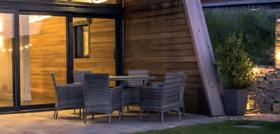



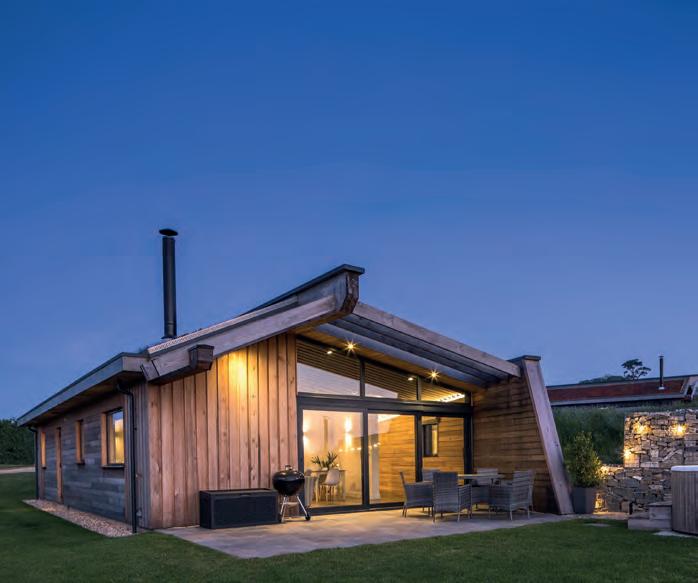






At






YOUR PLACE 4
PLANTS
www.basketsnblooms.co.uk OPEN 7days Week

Blooms Cafe at our West Parley branch - tasty local produce for an even more pleasurable visit



Stuckton, Fordingbridge, SP6 2HG
392 Christchurch Rd. West Parley, BH22 8SW 9am - 5pm Mon - Sat 10am - 4pm Sundays Tel: 01425 655150
Bedding plant trays/packs Lobelia, Petunias, Marigolds, Begonias, Impatiens, Nemesia, Verbena, etc. £2.99 per pack
Patio/Basket plants more than 100 varieties £1.49 each. 18 pots for £25
Dahlias, Osteos, Marguerites etc. in 1 litre (large) pots £2.49 ea.
Ivy leaf Geraniums £1.99
Vegetable plants and strips from £1.75 Geraniums (zonal Pelargoniums) £2.99
Alpines & Cottage Garden Plants
Bush and Climbing Roses: £9.99
Seeds: biggest selection ever from £99p per packet
Hanging baskets - traditional mixed and single variety, various prices.

Winchester College is opening its gardens to the public as part of the National Garden Scheme. The school raised more than £4,500 for NGS charities when it took part last year, welcoming more than 450 visitors.

Over the weekend of 3rd and 4th June visitors will be able to explore Moberly Garden, War Cloister, Bethesda Garden and the Warden’s Garden.
Members of the college gardening team will be on-hand to share their expertise on maintaining the grounds. This year’s focus will also be on how the gardeners have enhanced biodiversity within the school’s broader commitment to sustainability. Visitors will be able to spot wooden green hearts, which identify areas within the campus where the team has concentrated on nurturing existing wildlife and attracting more for the future.
Tickets cost £10 per adult (children go free) and can be purchased on the door. Homemade teas will also be available. The gardens will be open from 11am-4pm.
The countdown is under way for one of the biggest shows of the summer- the New Forest Show which takes place at Brockenhurst on Tuesday 25th July to Thursday, 27th July. It takes part in the heart of the National Park and offers visitors 30 acres of showground for the family. There is a strong horticultural connection over the three days and as well as cattle, sheep and equine competition there’s countryside traditions and demonstrations. Tickets are now available at www.newforestshow.co.uk/tickets
Over 30 gardens will be opening in Cattistock and the neighbouring Dorset hamlets of Chalmington and Sandhills over the weekend of Saturday ,June 10th and Sunday, June 11th.

The Uplyme and Lyme Regis Horticultural Society will be holding its Summer Flower and Produce Fair on Saturday 8th July at Uplyme Village Hall and playing field DT7 3UY, from 1to 5pm. Copies of the schedule can be downloaded from the society website www.ulrhs.wordpress.com
Stalls feature plants and bees, an artisan avenue, and a fun and games section. The Plants and Bees stalls have hundreds of plants from diverse nurseries and growers.

Artisan Avenue features a wealth of artisan producers with products for the garden and home..
Entry is £3 for all adults; 16 and under free. Part of the profits will support the Woodroffe School Gardening Club and the Flamingo Community Pool in Axminster.
In the picturesque Dorset village of Netherbury, between Beaminster and Bridport, there’s a not to be missed opportunity to see many wonderful gardens open together on one weekend on Saturday, 10th June and Sunday 11th June from 1pm to 5pm.
An amazing variety of gardens will be on view, from small enclosed village ones to large ones with sweeping views of the surrounding beautiful countryside. It is hoped eight gardens will be available for visitors to wander around This picturesque village, with a river running through it, a 14th-century Church and views of the Dorset hills, makes the perfect backdrop to the gardens. The village prides itself on the quality of the home-made lunches, teas and delicious cakes to refresh our visitors. Proceeds go to church and other local charities.
The Garden Show is back at Stansted Park in Hampshire from Friday, 9th June to Sunday, 11th June. Twenty-nine years ago the first garden show was created as a forum for the smaller family run businesses and to showcase the work of talented artisans particularly those who couldn’t afford the larger, more commercial shows. The first show consisted of about 30 enthusiastic stands and an art exhibition. The show has grown and expanded since then and turned into the perfect place to find all you need to make your garden grow and refresh your home.
Pick up top tips from horticultural experts to solve those frustrating problems - as ever the specialist plantspeople will bring their knowledge and brilliant advice On Saturday the show is joined by Dr Ian Bedford, entomologist, with The Pest Clinic to help solve any bug issues in as friendly a way as possible.
The show’s chosen charity is CancerWise - www.cancerwise.org.uk - aspiring to be an enabling, compassionate community for people with cancer and those who care for them.
Ticket prices on the gate Adult £12. Senior £10. Child £4 age 5 to 16yrs. Friday arrival 10am –to 12noon Tickets are limited - pre-booked only.
The popular Exbury Gardens is branching out in June to celebrate the majesty of trees with tree ‘listening’, climbing and exploring.
One of Europe’s most spectacular woodland gardens, will be offering visitors the rare opportunity to listen to the inside of a tree as part of a special series of tree-themed events.
The 200-acre New Forest visitor attraction will host The Tree Listening Project ( from 30 May to 2 July) which uses highly sensitive microphones to make audible the movement of water as it travels up from the ground to the leaves. Visitors can put on a set of headphones, listen in and get a deeper understanding of how the tree works.
Trees will also take centre stage in a new two-day Tree Climbing Competition (on 17th and 18th June) when professional arborists will compete in a range of tree-mendous events. An impressive spectacle, the competition will allow the public to find out more about skills involved in tree work. The event is being organised by Christopher Hoare Tree Services which will be setting up its climbing wall and throw-line game for Exbury visitors to enjoy.
Magnificent ‘veteran’ trees will be the focus of two garden tours hosted by Exbury’s expert gardeners (Wednesday 7 and Friday,23 June), and trees will also feature in an exhibition by the Solent Art Collective

‘What is one to say about June, the time of perfect young summer, the fulfillment of the promise of the earlier months, and with as yet no sign to remind one that its fresh young beauty will ever fade’
- Gertrude Jekyll, On GardeningWinchester College

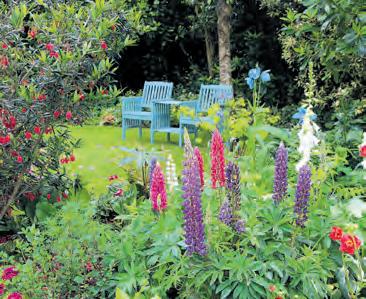
Hilary and Michael Pritchard are opening their one-and-a-half-acre garden for the National Garden Scheme and Axminster Hospital League of Friends over a long weekend at the end of June. This plantaholic’s garden includes many specimen trees, large collection of herbaceous plants, over 200 roses, woodland shrubs, dahlias, small orchard, vegetable patch, steep bank with trees, shrubs and wild flowers, with a lovely view from the top. Alpine troughs, alpine house, scented leaf pelargonium and succulents collections.
There will be a fretwork stall with beautiful wooden goods, occasional live music and a large plant stall well stocked with interesting plants.
The garden is two miles from Axminster on the A358, left at Weycroft Mill traffic lights. You pass Ridgeway Hotel on left and continue lane for half mile and you can park in field opposite.
The garden will open from 1pm to 5pm on Friday, 30th June, Saturday 1st July and Sunday 2nd July from 1 to 5pm.
Admission is £5 with children free. Dogs are welcome on leads and wheelchair access is available for most of the garden.
Socks Orchard, Smallridge, Axminster EX13 7JN

It’s Pond Fish Month at Devon’s Bow Garden & Aquatic Centre, and with it the opportunity to liven up your garden with a pond!
Ponds come with many other benefits, such as attracting wildlife.
You need to decide which type of pond interests you most and what you have room for. A Koi pond makes a beautiful feature, and will typically need to be larger in size, depending on the amount of Koi you intend to keep. Wildlife ponds are excellent for those with smaller gardens, needing only oxygenating plants, and if you want to add fish, Orfe’s make a great choice.
Adding pond plants to your pond will attract wildlife, such as birds, butterflies, frogs and newts. Plus, covering at least two thirds of your pond with plants will help to stop the build-up of algae. You will find everything you need for your pond at Bow, including a large selection of pond and bog plants.
There is also nothing more calming than the sound of flowing water and a water feature or stream will add peace and beauty to any garden or pond as well as making a spectacular focal point.
Bow Garden Centre is also packed with this year’s garden must haves – so it’s worth a visit to get some inspiration. While you’re visiting, sit back and relax in Bow’s Waterside Café where you can enjoy home-made food made with local Devon produce.
You can find Bow Garden Centre on the A3072 halfway between Crediton and Okehampton Tel: 01363 82438 www.bowgardencentre.co.uk
Wimborne in Bloom Open Gardens Day is all set to take place on Sunday 25th June.

A total of 22 gardens in and around Wimborne Minster will be open from 11am to 5pm to raise funds for Wimborne in Bloom.
Visitors pay £7.50 at the first garden visited. Start at any garden and in any order and the gardens are well signposted throughout the town.
Again the event is being held in the morning as well as the afternoon. Teas available at some of the gardens. Full details on the Wimborne in Bloom websitewww. wimborneinbloom.org.uk Any further details required please contact Les Halton on 01202 880131.
To celebrate the coronation of King Charles III, English Heritage and Plantlife are joining forces to create and enhance wildflower meadows at 100 historic sites around the country, creating a natural legacy in honour of the King’s love of nature.
Wildflower meadows will spring up in the next decade at ancient sites including Netley Abbey and Portchester Castle, recreating natural meadows which have been lost and revitalising those that already exist.
Since the 1930s and the advent of modern farming practice, the UK has lost 97 per cent of its wildflower meadows. English Heritage say that they manage many sites where, with the right management, meadows both large and small can flourish.
“Creating and enhancing wildflower-rich grasslands at these sites will not only benefit nature and our environment, but will also help evoke a sense of surroundings more familiar to their historic occupants,” said a spokesman for English Heritage.
Other historic sites in Hampshire that have been chosen are Silchester Roman City, with its walls and amphitheatre, Titchfield Abbey, Fort Brockhurst at Gosport, Flowerdown Barrows at Littleton near Winchester, and the Royal Garrison Church, Portsmouth. On the Isle of Wight, Osborne at East Cowes has been chosen as a future wildflower meadow site, where Osborne House and Gardens were Queen Victoria’s unique holiday home for her, Prince Albert and their children.
A new memorial garden is being created for the late Prince Philip in Poundbury, with the display being officially unveiled later this year. Landscaping work recently began on the new garden, which will be based on the Pavilion Green, near to the Royal Pavilion.
Works underway shows shrubbery will be planted in a circle, with some shrubbery already planted. Further landscaping planned for the site is ongoing, according to residents. Duchy of Cornwall confirmed the plans for a memorial garden are underway. Prince Philip died in April 2021 at the age of 99 and was later laid to rest at The George VI Memorial Chapel in St George’s Chapel with Queen Elizabeth.
When finished, the display will be the second memorial to a member of the royal family in Poundbury. The Queen Mother Square in honour of King Charles’ grandmother was unveiled by Queen Elizabeth and Prince Philip in 2016, where they took a tour of Poundbury.
Plant Heritage has officially accredited its 700th National Plant Collection, adding a further nine new collections to the charity’s growing list of ‘living libraries’. The milestone achievement comes during Plant Heritage’s 45th anniversary year, which is being celebrated throughout 2023 with a host of sapphire-themed campaigns, plus several regional and national events.
The first National Plant Collections (NPCs) were accredited between 1980-1982, after Plant Heritage created by ex RHS Director General Christopher Brickell in 1978. Fast forward almost five decades and many of these National Plant Collections are still thriving and remain a vital part of Plant Heritage’s wider plant conservation work.
Powerstock is hidden away in the folds of the lush green west Dorset landscape between Bridport and Beaminster.
Many of the open gardens on Saturday, 1st July and Sunday, 2nd July from 11am to 5pm have fabulous views as well as lovely gardens. All gardens will be open both days. This year there is a small holding open so children can meet the animals. You will be encouraged to walk around the village using the footpaths.
This weekend is also a celebration of the village hall’s 70th Anniversary. ‘The Hut’ will have displays about the community to look at, local produce, books and crafts to buy, live folk music, morning coffee and a lunchtime barbecue to sample.
Teas will be available on the lawn at Glebe House. Well behaved dogs on leads welcome.
All proceeds to St. Mary’s Church Bell Tower Restoration Fund and The Hut.
Pallington Lakes hosts a plant fair on Saturday, June 3rd and Sunday June 4th in the grounds of Sculpture by the Lakes, opening from 10am to 5pm on both days. It’s a great day out for garden lovers with small, independent nurseries selling unusual hardy perennials, herbs, alpines, cottage garden favourites and native wildflowers.
Sculpture by the Lakes, Pallington Lakes, Dorchester, DT2 8QU
The Summer Festival at Sculpture by the Lakes is a five-day festival from Wednesday 28th June to Sunday, 2nd July combining everything beautiful for your home… inside and out.
At the Fire & Food Outdoor Kitchen there will be running a series of BBQ demonstrations every day including Marcus Bawdon from the UK BBQ School, Pizza Masterclasses with Martin Sviba, Luke VandoreMackay from High Grange demonstrating Kamado Joe’s, Moroccan cooking with Simon Gudgeon, Vegan BBQ with Vegan Magda and many more. There will also be a selection of stalls cooking delicious food for you to eat whilst you watch.
Many exhibitors will not only be selling their works but also demonstrating their skills to allow you to appreciate the process of their craft. Watch pots being thrown, live raku firing, blacksmith forging, printmaking and much more.
Tickets £14.50 including entry to the sculpture park. Book tickets www.sculpturebythelakes.co.uk

Construction work has started on The Lookout, a new building commissioned by Dorset Wildlife Trust which will become the first nature destination for visitors to Brownsea Island. It has been designed to introduce the island’s diverse wildlife and habitats, with an elevated viewing platform which will provide spectacular views of the wetland habitats of the lagoon and the many birds which nest, breed, and feed there.
The Lookout is part of Dorset Wildlife Trust’s Wild Brownsea project which has been developed in partnership with the National Trust. It is part-funded by the National Heritage Lottery Fund with contributions from the National Trust, the Fine Foundation, and Dorset Wildlife Trust members and supporters. The Wild Brownsea project aims to improve access to Brownsea Island and encourage more visitors to learn about, enjoy and help to conserve the island’s natural heritage.
Gardening club events and meetings in Dorset and Hampshire. If your gardening club or association is getting back into full swing after the restrictions of the past couple of years be sure to let Country Gardener know. Send your club meetings and outings details to timeoff@ countrygardener.co.uk
2ND
Shaston Gardening Association
MONTHLY MEETING www.shastongardening association.weebly.com
5TH
Ferndown & District Horticultural Association
‘THE SIGHTS AND SOUNDS OF NEW ZEALAND’CHRISTOPHER LEGRAND
Details on 07790 089889
7TH
Dorchester & District Gardening Club
LIVES AROUND THE DORCHESTER BOROUGH
GARDENS
- BRIAN BATES
Details on 01305 268523
9TH
Blackmore Vale Bonsai Group
MONTHLY MEETING
Details on 07837 781744
27TH
West Parley Gardening Club
‘THE INTRODUCTION OF BEAVERS TO DORSET’DORSET WILDLIFE TRUST
Details on 01202 896711
West Parley Gardening Club
‘THE INTRODUCTION OF BEAVERS TO DORSET’
Details on 01202 896711
28TH
Sturminster Newton Garden Club
‘GARDENING FOR CLIMATE HANGE’ - CASTLE GARDENS SPEAKER
Details on 01258 471147
Uplyme & Lyme Regis
Horticultural Society
‘EDIBLE FLOWERS AND LEAVES - SIAN DAVIS
Details on 07767 261444
JULY
3RD
Ferndown & District
Horticultural Association
‘PLANTS AND LANDSCAPES OF THE WESTERN CAPE OF SOUTH AFRICA’
- BEN TURNER
Details on 07790 089889
5TH
Dorchester & District
Gardening Club
‘PELARGONIUMS’
- BRIAN CARLSON
Details on 01305 268523
7TH
Shaston Gardening Association
Social/Plant Chat & Swap
www.shastongardeninga ssociation.weebly.com
8TH
Uplyme & Lyme Regis
Horticultural Society
SUMMER FLOWER AND PRODUCE SHOW
Details on 07767 261444
11TH
The Radipole and Southill
Horticultural Society
‘THE FLORA & FAUNA OF TUMBLEDOWN FARM’
- BOB FORD
Details on 01305 788939
14TH
Blackmore Vale
Bonsai Group
MONTHLY MEETING
Details on 07837 781744
19TH
Sturminster Newton Garden Club
44th ANNUAL MEMBERS’
SUMMER SHOW
Details on 01258 471147
26TH
Uplyme & Lyme Regis
Horticultural Society
SNAKES ALIVE FOR RNLI WEEK
Details on 07767 261444
31ST
Warsash Horticultural Society
‘MAKE A BUTTERFLY
GARDEN’ - MARTIN YOUNG
www.warsashhorticultural society.chessck.co.uk
6TH
Medstead Gardeners Club
‘MY GREENHOUSE YEAR, PROPAGATION OVER WINTERING & DESIGN’
- GILLIAN TAYLOR
www.medstead gardenersclub.xyz
14TH
Cotton & District Society
‘HONEYBEES IN THE GARDEN’ - KRYSIA
WATSON
Details on 023 80292761
21ST
Milford Gardener’s Club
‘A ROSY START TO THE YEAR: TYPES OF ROSE, MAINTENANCE AND PROPAGATION’
- MARTIN PERRY www.milford gardenersclub.co.uk
23RD
Hordle Gardening Club
‘FUTURE DEVELOPMENTS IN HORTICULTURE’ - RAY BROUGHTON www.hordlegardening club.co.uk
24TH
Hayling Island Horticultural Society
COMMUNITY FAIR AND SUMMER SHOW www.hihs.org.uk
28TH
Uplyme & Lyme Regis
Horticultural Society
‘EDIBLE FLOWERS AND LEAVES - SIAN DAVIS
Details on 07767 261444
Warsash Horticultural Society
‘THE WHITE GARDEN’ - CHRIS BIRD www.warsashhorticultural society.chessck.co.uk
JULY
8TH
Uplyme & Lyme Regis
Horticultural Society
SUMMER FLOWER AND PRODUCE SHOW
Details on 07767 261444
12TH
Cotton & District Gardeners’ Society
‘GROWING VEG IN SMALL GARDENS’ - GEOFF HAWKINS
Details on 023 00292761
13TH
Petersfield Garden Club
‘HOSTAS’ - JOHN BAKER
Details on 01730 261651
15TH
Medstead Gardeners Club SUMMER SHOW www.medstead gardenersclub.xyz
26TH
Uplyme & Lyme Regis
Horticultural Society
SNAKES ALIVE FOR RNLI WEEK
Details on 07767 261444
Warsash Horticultural Society
‘MY JAPANESE JOURNEY’ROSEMARY LEGRAND
www.warsashhorticultural society/chessck.co.uk












The south west is thought to be home to 42 of the 59 butterfly varieties in the UK and gardeners are working hard to provide natural habitats and safe havens but how are you at identifying these colourful creatures
The plight of UK butterflies is well charted. Our butterflies are disappearing but thanks to millions of gardeners the fight back is well established as natural habitats and safe havens are regular features in our gardens and so many of us plant flowers, shrubs and trees specifically with the well-being of butterflies in mind.

Large areas of the south and southwest have wide selections of varieties to spot in our gardens. Dorset, Devon and Somerset are thought to be home to 42 of the 59 varieties of butterflies to be found in Britain.
But how many do you see in your garden and can you identify them?
You may be lucky to see the rare Heath Fritilary or Duke of Burgundy butterflies but for the most part your garden is likely to be enjoyed by the ‘usual suspects’ which give us so much pleasure.
A strikingly beautiful, red butterfly, so-named for the large blue and yellow ‘eyes’ on each upperwing that bare a marked resemblance to the tail feathers of a peacock. It is on the wing throughout the year, having a single brood, and overwinters as an adult. A very common butterfly, the Peacock is a regular visitor to our gardens where it feeds on buddleia and other flowers.
The Red Admiral is an unmistakable garden visitor. This black-and-red beauty may be seen feeding on flowers on warm days all year-round. It can be spotted feeding on buddleia and other flowers. It will also frequent all kinds of other habitats, from seashores to mountains! Adults sometimes hibernate and may be seen flying on warm days throughout the year, although they are most common in the summer and early autumn.
Reddish-orange with black and yellow markings on the forewings and a ring of blue spots around the edge of the wings.

The Small Tortoiseshell is a medium-sized, pretty butterfly that is common in gardens on buddleia and other flowers. It is on the wing throughout the year, having two or three broods and overwintering as an adult.
Male Small Tortoiseshells are very territorial, chasing each other, other butterflies and anything else that appears in their space. They court females by ‘drumming’ their antennae on the females’ hindwings.
Bright orange forewings with dark brown spots and a thick, dark brown margin. Dark brown hindwings, banded with orange.
The Small Copper is a small butterfly that is on the wing throughout the summer. Males are territorial and can be seen basking on bare ground or rock waiting for females, every now and again chasing off other insects that encroach on their space. Adults can be seen feeding on ragwort and thistles, while the caterpillars feed on common sorrel and sheep’s sorrel. The Small Copper has bright orange forewings with dark brown spots and a thick, dark brown margin.
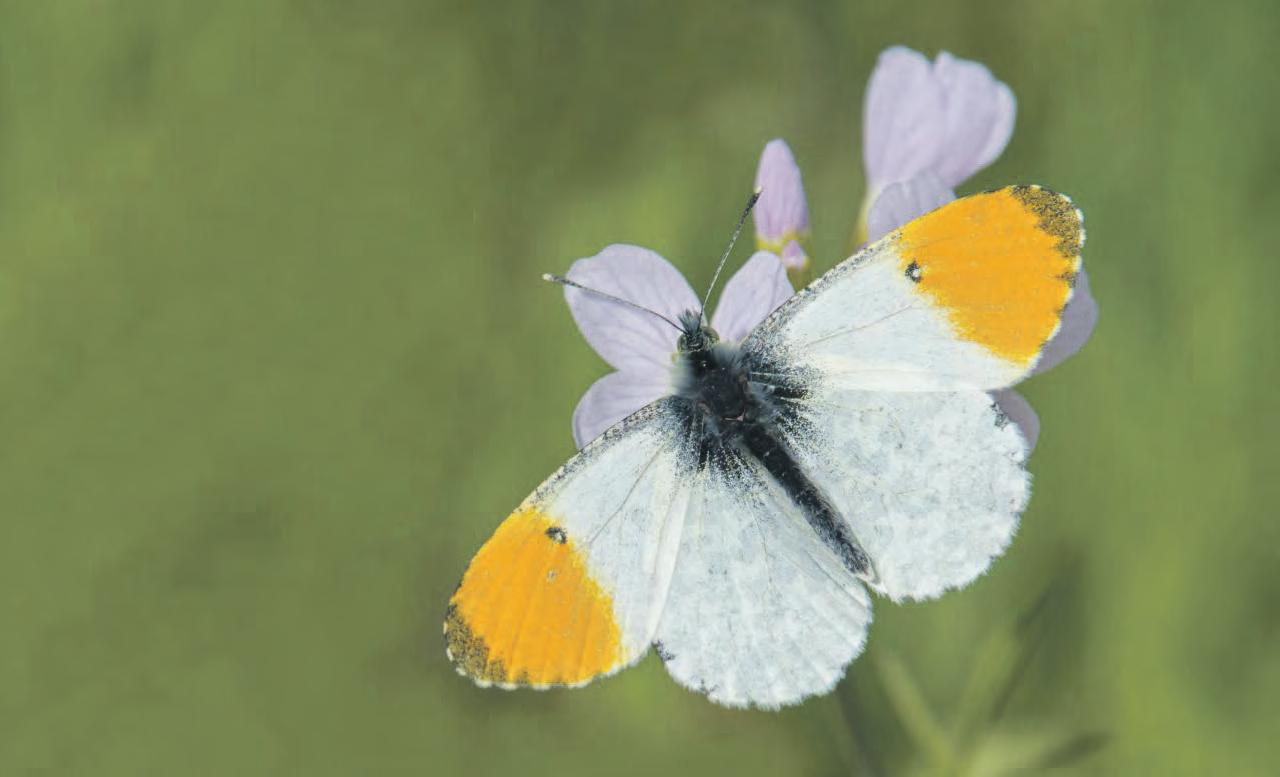
Males are white with bold orange patches on the forewings and light grey wingtips. Females are white with grey-black wingtips. Both have mottled grey-green undersides. These pretty little butterflies are easy to spot as the males’ wings have bright orange tips – giving them their name! They are a common sight during spring and can be found in lots of places including meadows, woodland and hedges. Orange-tip caterpillars love garlic mustard, cuckooflower and hedge mustard plants.
White with prominent black tips to the forewings. Females have two black spots and a dash on each forewing. Plain, creamy-yellow underside.

The Large White is a common, large, white butterfly that is often spotted flying slowly over cabbage patches in gardens and allotments, and over farmland; adults fly between April and October. Also known as the ‘Cabbage white’, the foodplants of the caterpillars of this butterfly are members of the cabbage family, known as ‘Brassicas’, hence its Latin name, Pieris brassicae
As its name suggests, the Small White is a small, white butterfly that is on the wing between April and October. A common butterfly, it is found in a wide variety of habitats, including hedgerows, farmland, gardens and parks.
 Small white
Small tortoiseshell
Small white
Small tortoiseshell
The Brimstone is a fairly large, pale yellow butterfly, with distinctive, leaf-shaped wings. Adults hibernate through cold weather, so may be seen flying on warm days throughout the year, although they are most common in the spring. Usually seen in ones or twos, they are never very common, but are widespread.
The medium-sized Meadow Brown is one of the commonest grassland butterflies, on the wing in the summer, from June to September. It also occurs in parks, gardens and cemeteries. It even flies in dull weather when other butterflies are inactive. Adults can be seen in large numbers, flying low over the grass and flowers. The Meadow Brown is mainly brown with washed-out orange patches on the forewings. The best way to identify the ‘brown’ butterflies is by looking at the eyespots on their wings.
The Holly Blue is a small blue butterfly that emerges in early spring, from March to May, and then again at the end of the summer between July and September. This is the blue butterfly most likely to be found in gardens, as well as woodlands, parks and churchyards. It tends to fly high around bushes and trees, whereas other Grassland Blue butterflies fly low to the ground.
Dark brown with creamy yellow spots. The best way to identify the ‘brown’ butterflies is by looking at the eyespots on their wings. The Speckled Wood is the only brown butterfly with three small, cream-ringed eyespots on each hindwing and one on each forewing.
• Butterfly Conservation www.butterfly-conservation.org – a website full of information. ID charts, gardening tips


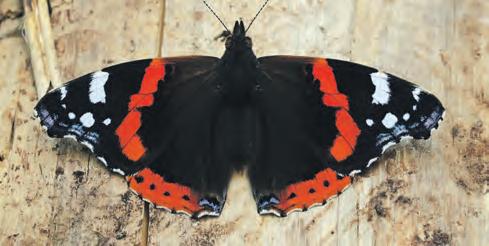

• iRecord Butterflies, is a completely free app and is available for iOS and Android devices. It will guide you through the identification of any butterfly that you see in the UK.
• Woodland Trust- butterfly identification and facts www.woodlandtrust.org.uk
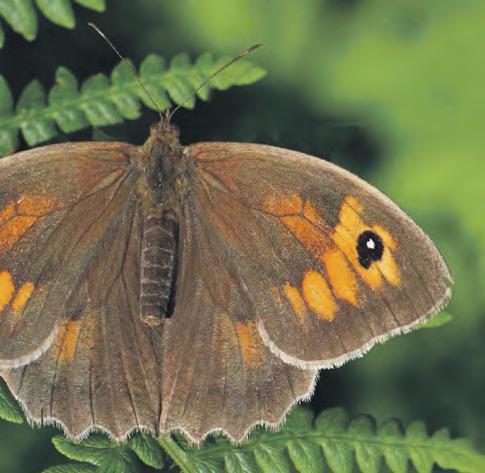

Is it possible to grow fruit and vegetables if you have a lot of shade in your garden? The good news is there are crops which will grow and grow well out of the direct sun.
It isn’t everyone who has a vegetable plot in a sunny and open position. Many gardens are limited by other properties and by trees in which it is difficult if not impossible to grow fruit and vegetables.
For many gardeners that’s the end of the story. A shady position which gets little sun isn’t going to be a success story when it comes to a vegetable plot.

But that isn’t necessarily true. Some crops will benefit from being out of the direct sun and if you can find a spot which gets three hours of sunshine a day then that should be enough to grow crops and more varied ones too.
Preparing the beds will be key. Add plenty of organic matter to improve the fertility and water holding capacity of the soil. If you can, try and improve the light and consider having lower branches of offending trees cut back if they are not the subject of tree preservation orders. It will make a massive difference, however little you can do to improve the light.
One benefit will be to start off some crops in pots. It will give them a head start before planting them on in the shadier areas. What you can try growing:
Swiss Chard
This is a good crop to grow and rewarding to harvest when the leaves are small. It over winters and therefore isn’t dependant on sunshine. Sow in April and start to harvest in August and September.
Another crop which will not need lots of sunshine and grows well in shadier , colder situations. Succession growing is key with beetroot so sow short rows every couple of weeks. You should keep an eye on them and pick when the size of gold balls or a little bigger.
Lots of varieties to choose from and spinach is a wonderful ‘out of sun’ crop because it grows perpetually and actively dislikes the heat of July and August. All the varieties will tolerate a lot of shade and growing will be easier if you avoid sowing in the hottest months of the summer.
Perfect for starting off in the greenhouse and then transferring to your shadier patch. Cover with fleece once you decide to plant out. If you are happy just to harvest baby leaves you should get a steady flow throughout the summer and again it is a crop which doesn’t appreciate too much heat and sun.
Perhaps the best crop for out of sun positions. Important as a crop because they are such a high value crop. Sow as seeds and then transfer when thin shoots appear in early summer and prepare for them to be regulars in your vegetable beds all summer and winter. There are varieties which will benefit from being in the shade but generally this is another crop which just doesn’t like the sun.
Attracting butterflies into your garden should be part of a long-term plan not a quick one- summer fix. The secret is understanding what their needs are - and managing your garden accordingly
Butterflies and flowers were made for each other, and there are certain flowers that butterflies absolutely love to be around. As a French poet once pointed out, “Butterflies are flying flowers, and flowers are tethered butterflies.” In attracting butterflies to your garden, it’s important to understand what they want most out of life: nectar. The ancients, who believed that nectar fell directly from heaven, named it after the wines of the gods. Butterflies will visit any garden, however small, if they can feed on suitable nectar plants and a well thought out garden can attract many species of butterfly. If you manage your patch to create a breeding habitat the chances are you will see many more in your garden. Nectar provides butterflies and moths with energy to fly and find a mate. In spring, it helps butterflies refuel after winter hibernation or a gruelling journey to Britain from southern Europe or Africa.
Do your bit for butterflies by making them welcome in your garden. Adults feed on nectar, and can be seen nectaring on flat, daisy-like blooms as well as plants with long, tubular flowers. The more of these you can grow in your garden, the better.
To see butterflies in your garden, you need to entice them with the right flowers. Adult butterflies feed on nectar that they will take from a wide variety of wild and garden flowers, particularly those growing in warm sheltered places. Butterflies can be encouraged to visit gardens by growing a range of suitable flowers from March until frosty weather ends the butterfly season in October and November.
If you want to keep butterflies in your garden (and support these declining pollinators), you must have those host plants where they can lay their eggs (some butterfly species are fussier than others as to what plants are best); once the larvae hatch, the host plants will serve as food for the developing caterpillars.
Preparing your garden to welcome butterflies isn’t a one off. It should be a long term plan year after year planting the right things and seeing the butterfly population grow. Here’s some good options when it comes to selecting what to plant.
Very easy to grow in almost any soil. Different varieties will flower in pink, red, purple, and white. Usually in bloom through July and August.
Stems up to a metre tall support heads of lilacpurple flowers from August to October. Easy to grow from seed, plant March to April in welldrained soil. These can provide useful height at the back of a border. Only half hardy so can be a short-lived perennial.
Red
Performs best in poorer, dry or chalky soils, where it forms a tidy, compact plant and won’t be overwhelmed by other, stronger plants. It often flowers early and continues well into midsummer.
Lavender
Flowers are a purplish-blue in colour and grow on spikes through the summer. Plants can be used for edging beds or grown to form an attractive, low-growing hedge. It thrives in a sunny, sheltered position in well-drained soil. Lavender should be planted in April or May and pruned back to encourage bushy growth.
Perennial
Produces a profusion of sweet-scented purple flowers from April all through the summer. Wallflowers make great bedding plants and will grow well in full sun or light shade. Plant in well-drained soil.
A perennial herb, growing from 20 to 80cm tall. White, pink or purple flowers grow on spikes from June to September. A good edging plant and useful ground cover, requiring little maintenance. The smaller varieties also do well in rock and alpine gardens.
Hylotelephium
Always go for the old-fashioned pink form of Hylotelephium spectabile, which produces the most nectar when it flowers in autumn. Red varieties tend to be poor in comparison.
If you’ve created an area for wildflowers in your garden, then Centaurea nigra is a must-have. The bright, violet flowers will attract a range of butterflies, including the common blue and meadow brown.
They might not seem an obvious choice, but these plants help butterflies too. Some have flowers that benefit adult butterflies, others are valuable food plants for caterpillars.



• Trees and shrubs like hawthorn, holly and bramble.
• Herbs like rosemary, thyme, sage, oregano and mint.
• Ivy is a key source of nectar in autumn, when many other plants have finished flowering.
• Nettles. They’re not a garden favourite, but stinging nettles are an important food source for the caterpillars of Small Tortoiseshell, Red Admiral, Peacock, Comma and Painted Lady. Plant them in a quiet part of the garden away from places where children play.
• Butterflies like warmth so choose sunny, sheltered spots when planting nectar plants.
• Choose different plants to attract a wider variety of species. Place the same types of plant together in blocks.
• Try to provide flowers right through the butterfly season. Spring flowers are vital for butterflies coming out of hibernation and autumn flowers help butterflies build up their reserves for winter.
• Don’t use insecticides and pesticides - they kill butterflies and many pollinating insects as well as ladybirds, ground beetles and spiders.
• Don’t buy peat compost. Peat bogs are home to many special animals and plants, including the Large Heath butterfly, which is declining across Europe. There are now good alternatives to peat.

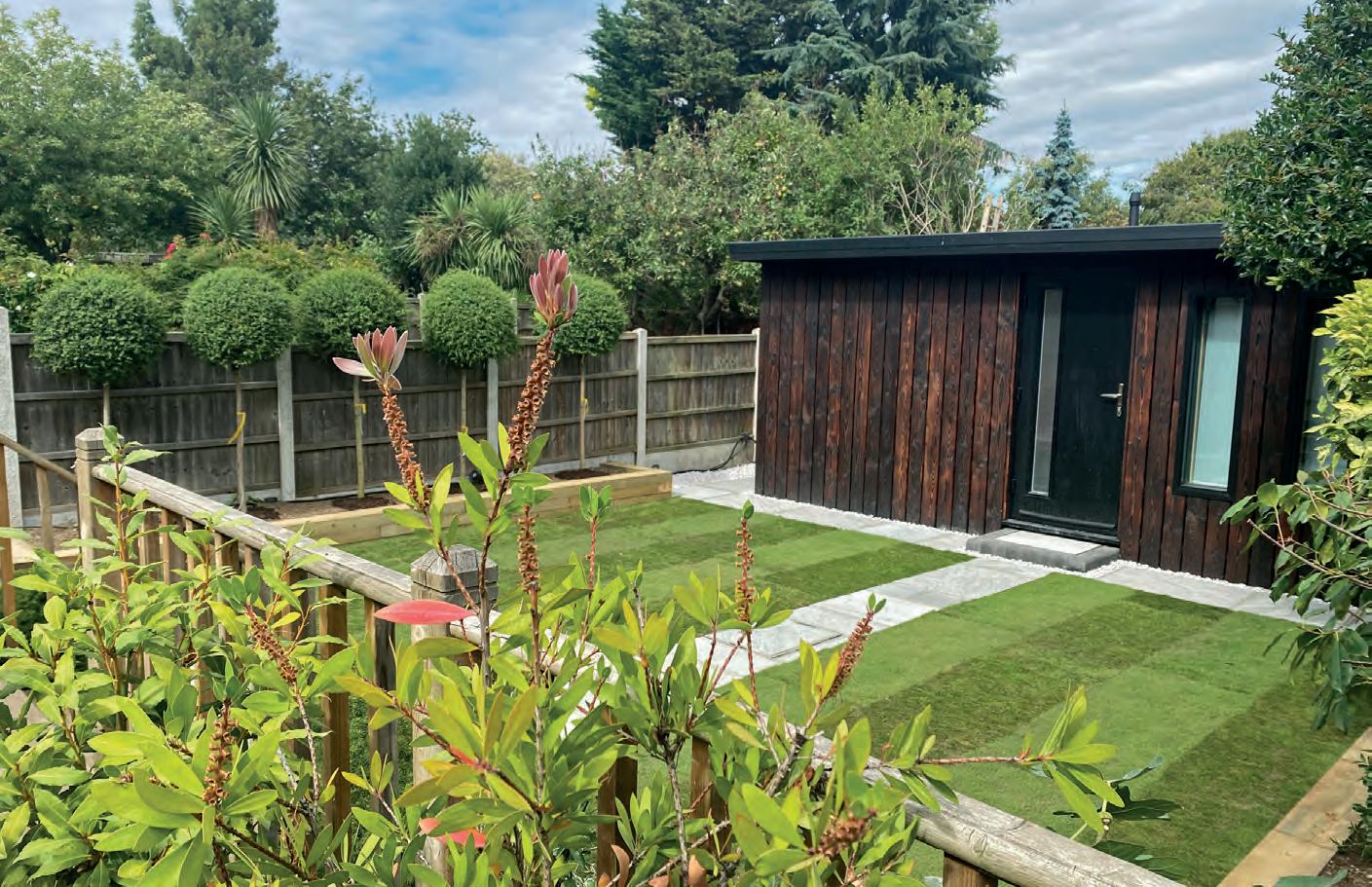






Large Selection of Perennials (Cottage Garden Plants),Trees, Shrubs, Herbs, Alpines and Vegetable Plants. Plus large selection of Ornamental Trees, Fruit Trees and Climbers.



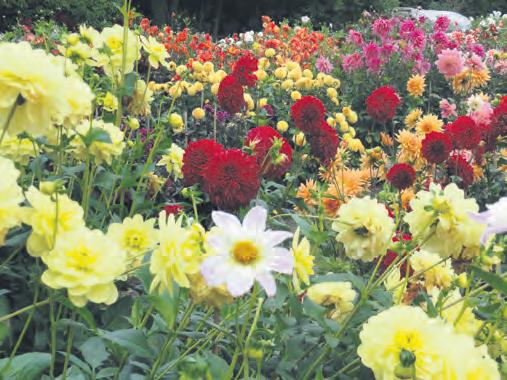



Good range of OUTDOOR
POTS - all frost proof
GREAT OFFERS
ON COMPOST (all compost we supply we use ourselves, so we can recommend it)



DAHLIAS
Our own Dahlia tubers now available for sale

Diane Redfern defends the much disliked nettles and sees they have more than one role to play in the story and benefits to our gardens
Why do nettles have such a problem reputation? Instantly attacked as needing to be cleared from the garden, nettles have a role to play in our botanical structure which shouldn’t be ignored.
An ideal plant food, essential for the health and wellbeing of butterflies and caterpillars, a worthy ingredient of a soup alternative, there remains a strong reason that every garden should leave a nettle patch untouched and uncleared through the spring and summer. Nettles make an ideal plant food especially for use in the greenhouse. They have more nitrogen and less potassium than comfrey, so they are best for feeding leafy greens such as salad leaves and brassicas. Select younger leaves, as they contain more nitrogen and less tough cellulose and lignin, so they break down quickly in water. Fill a container half to three quarters full with leaves, top up with water, then cover it and wait three to four weeks, then strain the solution. The resultant mixture may need to be diluted to the colour of weak tea.
However, even more important is that most of our favourite butterflies depend on nettles as the only food for their caterpillars. Here they are - the Peacock, Small Tortoiseshell, Red Admiral and Painted Lady. Sometimes

Comma butterflies lay their eggs on nettles too, as do several types of moths.
They are vital for the lives of our most well-known butterflies. The adults are not nearly so fussy and will take nectar from a wide variety of flowers! The caterpillars are really not even fond of the small nettle or dead nettles so it would be good to boost the declining numbers of these beautiful insects by providing a patch of nettles in a sunny corner of the garden.
I have read that it is possible to provide nettles in pots but Butterfly Conservation says that this does not really work because they need a much larger and wilder area safer from predators.
Being unaffected by their well-known sting, nettles are a good choice for caterpillars because they offer protection from predators including that from herbivores such as cattle, sheep and deer, all of which are keen to avoid the sting.
Birds too love to find caterpillars especially when they are feeding youngsters. I have read that each chick can eat 100 caterpillars a day so five chicks would need 500 caterpillars. Exhausting work and no wonder a butterfly needs to lay so many eggs.
The eggs and larvae of these butterfly species are present on nettles between April and June, with adults emerging between May and October. Insects employ various ways to survive. Female butterflies lay many, many eggs during their short life to ensure that even a small number of these eggs will survive.
Caterpillars (butterfly larvae) hatch from eggs. The eggs are usually laid in a protected location on the nettles that
the soon-to-be caterpillar will eat. Often, as they grow, the masses of larvae surround themselves in silk webbing to provide protection, so that they don't become a feast for passing birds.
It's important to treat nettles like any other garden plant if you are growing for the benefit of butterflies. Cut them regularly to get good fresh growth from the nettles. March and October are good months but ensure that there are no eggs or larvae on the leaves. Watch out for any leaves that are curled or folded in any way.
The Peacock butterfly lays her eggs in batches of 400 eggs, a process that may take two hours. She will choose the middle of a large nettle patch often next to a woodland edge or hedgerow. After two weeks or so the first larvae(or instars) hatch and start to build a communal web around themselves for protection whilst eating day and night. As they grow they will move on to new leaves. They moult again into the second instar which is twice the size of the first.
After as little as four days the larvae moult into the third stage, still in their communal web. They eat by day and night and when one leaf is eaten they move on to a new one and make a new web. After a week the larvae moult into a fourth stage or instar and a new web is made.
Altogether there are five instars. The caterpillar is now about 42 millimetres long and fully grown and must individually start looking for a place to pupate. Once a site has been two weeks the pupa colours up when the wings of the adult are clearly seen through the pupal case before the actual butterfly emerges, if it has been very fortunate.
Most of us realise that nettles are edible and do you good, but we may be reluctant to eat them because they sting! In fact the sting disappears once the nettle is cooked. Nettles provide us with iron, vitamins (B, C ) flavonoids, proteins and other essential minerals too. Here is a simple recipe to try – nettle soup. It comes from the book Wild Food by Roger Phillips.

Firstly, prepare the nettles using young leaves before they flower. Wash and drain them. Nettle soup freezes easily which is a plus.
Chop up one large potato, one carrot, one onion and garlic to taste. Sauté them in a two-litre saucepan with a tablespoon of olive oil and a bit of butter to taste. When the onion starts to soften and the potato is forming a slight crust, drop in the nettles and give them a quick whisk around with a spatula. Then add a litre of boiled water and two to four cups of stock. Stir it all up and let it bubble for about 12 minutes, or until the potato is soft. Liquidise it once it has cooled, then return to the pan to warm it when you are ready to serve. To serve, pour the soup into a bowl and add some cream.

Conservatory Insulations C.H.R.I.S ® system ensures the very best performance for your conservatory, giving you a room to use all year round, whatever the weather!



Having already installed over 30,000 systems to date, you can rest assured in the knowledge the C.H.R.I.S. ® system is the very best available on the market today and is the only system specifically designed for conservatories.




The C.H.R.I.S ® system is a cost-e ective solution which insulates your conservatory for a fraction of the cost of a new tiled roof. For complete peace of mind, we o er a 10 year insurance backed guarantee.


If you have any queries, problems or gardening issues you would like help with then we are here to help. Send your questions to Country Gardener, Mount House, Halse. Taunton TA4 3AD or email us at editorial@countrygardener.co.uk
I dread the start of the real growing season as if things go as they normally do, I am about to be overwhelmed by slugs. Is there any foolproof way I can get on top of these slimy creatures before they damage my plot.
Chris Bowden Liss
The recent wet weather has started the slug season off early but there are things which will lessen the problem. Use compost as your main mulch and not hay, straw or grass. Compost offers fewer hiding places. Try and reduce slug populations at surface level and one way of achieving this is to water less frequently. The soil surface drying out means less usual habitat. As the season progresses make sure you clear up fading leaves which sit on the ground. They attract slugs and give them a damp home. Put the work in with collection and disposal. Getting out in the vegetable bed in early morning and dusk normally ends in a sighting of lots of slugs which can be collected and disposed of.

I have a tall, vigorous and healthy dogwood in my border. The problem is it is growing too tall and dominates everything around it. Can I cut it back without damaging its health?
Eric Webster Martock
Dogwoods are very resilient and will cope with aggressive pruning, but you may have to do it in stages. It will then regenerate from old wood. You should cut down stems to about 30 cms from ground level from April and early May in year one. This should be a part of a two-year plan so it’s less of a shock for the shrub. It will also thicken from the bottom and achieve more of the shape and size you are looking for.
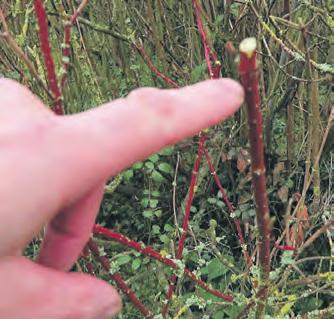
I planted half a dozen autumn raspberry canes in a special part of my border. The plants look healthy enough, but I can’t see anything happening which will result in my getting any fruit. I am not sure what to do .
Ann Roy Chichester
Raspberries take their time to establish in a garden and there is some patience called for here. They tend not to produce fruit in their first year. You should have by now cut back all the canes to the ground. New canes will appear next spring and it is these canes which will bear fruit next summer and autumn. Raspberries also respond to a good balanced fertiliser, and you should also mulch well to keep moisture in the soil during the summer. In dry spells keep the canes wellwatered as all this will be an investment into next summer’s fruit.
A recent trip to my local garden centre left me bewildered about how to choose which compost I should buy. I counted at least 25 different options and although there was some basic information, I just couldn’t see how anyone can decided which one to choose. Are there any guidelines here?



Greta Woodburn
Barnstaple
The choice can be overwhelming but there are some quick rulesalways look for peat-free is the starting point. For general use multipurpose compost is the ideal choice while special mixtures such as houseplant or seed composts are designed for specific jobs. Potting compost is quite expensive so only select that for container growing and instead use a soil improver as a mulch. Compost deteriorates when stored for long periods as the organic matter breaks down and the fertiliser within it can be washed out. Therefore, never buy old stock or stock with faded labels and if possible, buy compost which has been stored under cover. Buy the largest bag you can handle to help reduce plastic wastage.
I am planning to grow tomatoes in my new greenhouse which will be ready for use in late May. My first question is will that be too late to get a crop this summer. And secondly should I choose F1 varieties to grow?
Jill Rea DorchesterTomatoes planted in late May from seed should be able to catch up but you might like to be on the safe side and buy some plants which are already established. Seeds are best sown under cover in March and April ready for harvesting from July to September.

So, you may be a few weeks behind. Tomato seeds usually germinate in seven to 14 days if you maintain a steady temperature of 21°C. Pot on the tomato seedlings as soon as they’re big enough to handle and they will grow very fast after that.
To sum it up, an F1 tomato is a first-generation hybrid tomato plant resulting from the cross-pollination of two carefully selected parent plants. These hybrids often exhibit improved qualities such as increased yield, better disease resistance, and enhanced growth vigour so they almost always represent the best choice.
My garden is increasingly full of lichen. It’s on the apple trees and lots of my shrubs. It doesn’t look good and I am worried it is harming things.
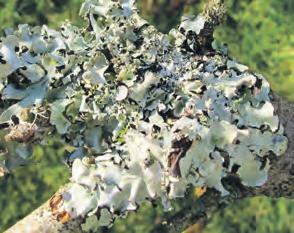 Peter Bower Plymouth
Peter Bower Plymouth
Lichens use trees and shrubs as a suitable surface on which to grow and they do no harm and are part of the garden’s biodiversity. However, their presence at the tips of the branches on a plant can indicate a lack of vigour so keep a close eye on it during the summer by seeing how much it grows. Shade and shelter create an environment that encourage lichens so pruning nearby shrubs which might be taking light away could see a reduction in its growth. The apple tree will appreciate more light and air.
Shrubby and leaflike lichens can only survive in clean air. Lichens are relatively rare in large cities and in areas of very heavy air pollution, there are no lichens of any type. Because lichens have no specialised protective barriers, they also readily absorb contaminants and are among the first organisms to die when pollution increases, making them good sentinels for air quality.
I have had a thriving lemon tree for three years and it has lived inside and just outside the greenhouse during the year. Over the past few weeks, the leaves have begun to drop off and it is looking very sad and there are now very few left.
Maggie Horton, TauntonCitrus are evergreen but do drop leaves, usually when they are stressed, too cold, have too much fertiliser, or not enough fertiliser, if there’s frost, or they are too wet. So there’s a lot which might be going on.
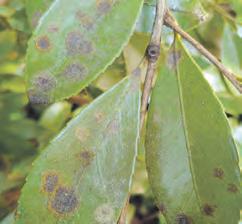
When the tree drops leaves due to high heat or water stress, if conditions return to normal, the tree will start to grow new leaves within a couple of weeks. Citrus trees are heavy feeders so you may not be fertilising it enough. You could try and apply composted manure around the base of the tree – taking care not to let it touch the trunk – and water it deeply to help the nutrients soak in.
I am terrified my normally healthy box hedge is showing signs of being ill and I wonder if it is blight which is starting to affect it. How can I be sure about this and what can I do? I have had the hedge for 20 years and it would be such an upset to lose it.

 Jenny Gill Liss
Jenny Gill Liss
Box blight is usually caused by Cylindrocladium buxicola or Pseudonectria buxi, both fungal infections making the leaves turn brown or grey/ pink or bronze and causing dieback of the plants stems. Conditions of warmth and moisture in the hedges and topiary specimens can spread quickly. Box blight is not a death sentence. If you are unfortunate enough to have blight in your garden, above all else, act quickly. The sooner you remove and destroy infected plant material the quicker the outbreak will be brought under control and permanent damage will be minimised. Remove the infected wood, recommended where the disease has been caught in its very early stages it is often possible to cut out a little more than may appear necessary in conjunction with a fungicide application both before and after.
Hard pruning to remove infected parts; if you catch the disease reasonably early it may well be possible to reduce your hedges by 50 per-cent or more on a dry day, being sure to remove every scrap of the trimmings and fallen leaves to the bin or bonfire. It pays to cut back further than you think, the infection can be latent in apparently healthy wood so be brave, they will grow back!
With the weather warming up, many gardeners will be thinking about how to make the most of green spaces. The charity, SongBird Survival, want us to think about how we can create a refuge for birds in our gardens too.

More than half of our UK songbirds are threatened or already in decline. Total population numbers have fallen 50per-cent in 50 years including some familiar garden visitors seeing drastic declines. Songbird Survival have launched a one stop shop to support gardeners with free advice to help birds thrive, as a part of their ‘Gardens for Birds’ campaign.
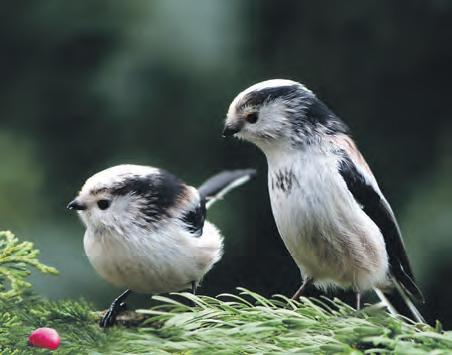
A keen gardener can be nature’s greatest ally, encouraging wildlife by providing much needed habitat for our native birds. You don’t need to feed the birds actively to provide for them year-round with clever plant choices that flower and fruit at different times of year. Why not try:
• Planting long grasses such as feather reed grass to provide nesting materials in springtime.
• Create a water source in the form of a bird bath or a wildlife pond that is cleaned regularly.
• Planting trees and shrubs are a great form of shelter. Elder, rowan and dog rose are all fantastic choices for birds to nest in and hide from predators.
• Plants that bear fruit such as blackberry, guelder rose or wild cherry attract insects with sweet flowers, and the fruits make great food for birds.
My compost this spring has been full of slow worms and I am never sure whether I should move them on or just leave them in the compost bin.
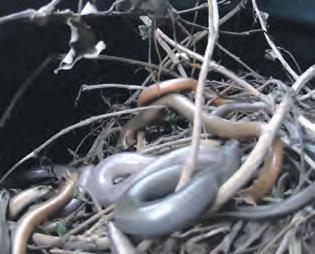 Steve Mills Exeter
Steve Mills Exeter
A regular denizen of your compost heap, the sleek and beautifully smooth slowworm is undoubtedly a keen gardener’s friend for its favoured meals tend to include both slugs and snails. Slow-worms are in fact protected under the Wildlife and Countryside Act 1981, so they should be left alone. Should you be lucky enough to have them living in your garden, remember that they are completely harmless and will spend most of the spring and summer munching up those pesky slugs for you!
My beloved potted camellia has small brown nodules under its leaves. Some of the leaves are so bad they have fallen off. I have had this problem for a number of years, but things seem to right themselves and the plant recovers. This year the young leaves are affected, and the problem seems a lot worse. What is going on?
Dave Gibson WatchetYour camellia has oedema which is a physiological disorder rather than a pest or disease. It occurs when roots take up water faster than the plant can use it. Water pressure builds up in the internal cells of the leaves causing them to burst leaving dead cells which look like blisters. This really comes from over watering or very high humidity or even wet soil which doesn’t drain properly. So, you need to address the water levels. If the plant is soaked then try ere-potting or for the less severe cases just let the plant dry out and hold off watering.
• Companion plant to avoid the need for pesticides as birds are nature’s best pest controllers!
• The natural approach, less is often more, but that doesn’t have to mean an unkempt garden! Try leaving a small section of your lawn as a wildflower meadow, which would be a fantastic haven for bees and butterflies.
• Reduce pruning and let seedheads develop as valuable bird food in the autumn.


• Honeysuckle - a great choice for small gardens, these climbers attract insects and provide shelter for nesting tits.
• Hawthorn - Quick growing, hawthorn provides dense shelter for birds, with the haws attracting hungry redwings and fieldfares.
• Ivy - another great climber that provides shelter and food. The berries are great snacks for starlings and blackbirds, and the caterpillars feasting on the leaves are food for hungry chicks.
• Teasel - is known for attracting bees, butterflies, and birds alike. The flowers provide seedheads that are a favourite of goldfinches.
• Sunflower - the happy garden staple that comes in all shapes, colours, and sizes. Sunflowers provide masses of seeds for birds and are an attractive feature to any wildlife-friendly garden.
Check out the SongBird Survival website www.songbird-survival.org.uk for more information and follow on Instagram, Facebook and Twitter to keep up to date with the Gardens For Birds campaign. To get involved in the open gardens scheme, contact dawn-chorus@songbird-survival.org.uk
Long tailed tits Blackbird Blue tit BullfinchJacqui Hunter, 60, who lives in Northamptonshire, is one of those people. She runs her own event management consultancy for the medical and pharmaceutical industries, as well as enjoying a busy life which includes, golf, yoga, gardening and travel.

‘I used to suffer with great discomfort in my knees and neck, particularly when going up and down the stairs.’ she remembers.
‘I read about the benefi ts of turmeric around three years ago. I’ve spent lots of time in Goa where it’s often used, so I was intrigued to learn more.
‘Having a background in the pharmaceutical industry I research products thoroughly. I really liked all the science and studies behind Turmeric+.’ Turmeric contains compounds called curcuminoids, the most notable of which is curcumin. Not only is curcumin responsible for turmeric’s distinctive yellow colour but it’s also what makes it such a powerful spice.

However curcumin is difficult for the body to absorb so the scientists at FutureYou Cambridge used a patented Curcuma Phospholipid Complex formulation to make Turmeric+ 30 times more absorbable than standard turmeric powder.
They also added vitamin C, which contributes to normal collagen formation for the normal function of cartilage and vitamin D, which contributes to the maintenance of normal bones and maintenance of normal muscle function.
FutureYou Cambridge are renowned for developing the highest quality health supplements backed by leading scientific research. The Cambridge-based company, who actively work with highly-regarded scientific and nutritional experts, is offering you the opportunity to try its bestselling joint supplement, Turmeric+, for free, for 28 days.*
Turmeric+ contains the most scientifically documented bioavailable curcumin formulation in existence, having been the focus of 45 human studies involving over 2,000 subjects. It has also been officially recognised and certified by Informed-Sport. The patented curcuma
phospholipid complex formulation features a unique phytosome delivery system to significantly increase curcumin bioavailability; an advanced natural alternative to black pepper. Pharmacokinetics studies show it enhances curcumin absorption by 30 times.
The vegan-friendly formula contains the full bouquet of curcuminoids including high levels of demethoxycurcumin (DMC), the most powerful curcuminoid. It has also been combined with vitamin C which contributes to normal collagen formation for the normal function of cartilage.
‘We want to support more people to become or stay active. We think Turmeric+ can
play an important role in that journey.
‘We offer people their first pack of Turmeric+ for free so they can experience the high quality, patented curcumin formulation for themselves. Most will know if it’s working for them within four to eight weeks – and if they like it, they will stick with it.’ says Adam Cleevely, FutureYou Cambridge’s Chair.


‘I’ve been genuinely amazed by the effect of Turmeric+. It’s transformative. As far as I’m concerned, I’ll be taking it for the rest of my life.’ said James, 54, from London.

Many of us like to lead active lives, but that can become increasingly difficult if we begin to experience skeletal and muscular issues. A growing number of people are discovering that a product called Turmeric+ can help keep them active and living the life they love.
“I really liked all the science and studies behind Turmeric+.”
If you have any views, opinions or ideas you would like to share with us write to Country Gardener at Mount House, Halse, Taunton TA4 3AD or email us at editorial@countrygardener.co.uk
I’d like to share with your readers what I believe is the perfect pear to grow. It is the Rolls Royce of pears and after growing it for half a dozen years now I really recommend it. The variety is ‘ Beurre Hardy’ and is an old French pear from Boulogne which was introduced into the UK in the middle of the 19th century. The flesh has a taste of rosewater. It seems trouble free with excellent disease resistance and becomes ripe to eat in October. It is now quite easy to find but I would go a long way to get one.
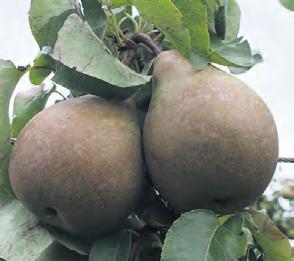 Mick Butler by email
Mick Butler by email

More urgency needed to switch to peat free
I was lucky enough to study at RHS Wisley and my grounding in horticulture I like to think was thorough and detailed. It certainly set me up for a career in gardening where I now run my own landscaping business. Amongst all the wonderful advice I learned while I was at Wilsey one thing has stuck with me and it is something I pass on to my customers - it is the importance of keeping a garden notebook. I have kept notes ever since I scribbled in small black books, easy to slip into trouser pockets. The pads are a little smaller that A5 and are a real mixture of weather charts, to-do lists notes on different vegetable cultivars, perennials I want to grow, shrubs which have proved to be difficult and disappointing. In idle moments I flick back through them and they really are a wonderful memory of triumphs and disasters and I do not understand now how anyone can keep a garden and not have this sort of record.
Linda Howells PetersfieldI believe more urgency is needed from nurseries in switching to peat free. There are some old-fashioned nurseries and garden centres who seem to have adopted the approach that peat has always workedwhy change it? I am aware, naming no names, that there are some garden centres around where I live who have done nothing to move to peat free and I am sure they are out of touch with what we common gardeners believe and in the short term will lose customers if they refuse to change.
Harvey Porter Petersfield
I visited two NGS gardens featured in your excellent magazine over the past few weeks and both outings have been spoilt by dogs. I appreciate that in both cases they were on a lead but I want to enjoy gardens without hearing barking, falling over dogs and having to look at the ground in case of mess. Gardens should remain tranquil places where one can appreciate plants undisturbed.
Mary Carter Arundel

Does anyone else feel as strongly as I do at what seems to be the expansion in the market of artificial plants? I am not a great fan of a couple of local garden centres and that hasn’t been helped by the sale in both of an extended range of artificial, plastic plants. Plastic pots are bad enough but plastic plants! I challenged one of the staff the other week and was told they were really popular because no upkeep was needed and they looked superb and in many cases couldn’t be distinguished from the real thing. This surely needs some sort of campaign to ban them and it does seem very inappropriate. Garden centres must surely be focused on selling living things.
Caroline Bentall TorquayI have been celebrating the anniversary of my beloved cactus which I bought for my son as part of a school project when he was twelve. He looked after it remarkable well until he left for university when I took over its care. He is now 56!
Jo Pearson DawlishI started to top up my raised beds last week and was able to do so with about 50 wheelbarrows full of peat-like mulch which will be the basis of all my vegetable growing this summer. My technique for composting is neither sophisticated nor hard work. I have an open area at the bottom of the garden and everything goes on to it, leaves, grass cuttings windfall fruit, prunings, vegetable slops from the house and lots of cardboard. When I first started a few years ago I wasn’t sure it would work but it did, and it still does. In the New Year I water it all thoroughly and trample it down but never get involved in the hard work of turning it. Wetting it helps I imagine creating an almost anaerobic environment. But hey it works and I often have a chuckle when I read how the compost has to be turned and how it must have equal brown and green elements.
I started gardening in lockdown and am a real convert and love it. I only have a small patch of garden but I have crammed it with colour, height and even a small raised bed which will soon have lettuces and broad beans growing. I love your magazine and it is a great source of advice but one thing I don’t read often enough is for a gardener like me (I am 20) to accept the fact that not everything will work and there will be failures and disasters. In a short time I have learned that and also I hope remember what I have done wrong.
Josey Graham BathMy husband and I enjoyed your collection of old wives tales in the last magazine He remembers his father who was a senior gardener at one of the big estate houses in the Cotswolds in between the wars, using the trick of hammering a nail into a tree to bring it to life – an act which he was convinced worked well.
Pam Harrison BridgwaterI attended a gardening club talk last month on getting to know your soil. The speaker began by asking the audience how many of us knew the constituents of our garden soil. Had we tested it, he asked. There were roughly 30 people in the hall and only about five raised their hands to show they has tested their soil and they knew what they were dealing with. I really hope this is not a true reflection of the nation’s gardeners. One of the most important constituents of soil is the pH. Whether your soil is sand, clay or chalk directly affects what you can grow and how successful it will grow.
Kate French Plymouth








Now is the ideal time to take cuttings from any hydrangea shrub. Take a cutting from a branch of the hydrangea shrub about five inches long. The belief is the cutting will work best if taken from a branch that did not flower this year. Remove the lower leaves of the bottom two leaf nodes. The leaf node is where a leaf comes out of the branch. Remove the lower leaves from the stem and if the top leaves are large, cut them in half to help reduce water loss and wilting.

The longest day of the year is amazingly only a few weeks away and the garden is growing at a rapid pace.
The frenzy of spring should be slowing into a more regular rhythm. The hundreds of young plants you have been raising should have left the confines of the greenhouse and are now making their own way in the world. Consequently, all you must do in terms of your gardening jobs is keep up with the watering, weeding, grass cutting, hedge trimming, etc, etc.
Cordon tomatoes are best grown as single-stemmed plants. However, these vigorous plants naturally produce side-shoots from the joints where leaves sprout from the main stem. These side-shoots should be pinched out to keep plants growing vertically on just one stem. Large side shoots can be used as cuttings to start other plants. You can stand them in a glass of water for a week or two or use rooting gel. Sometimes tomato growers allow a large side shoot to grow into a second main stem. This has the advantage of growing more trusses at a lower height from one plant
Bush varieties, also known as determinate, do not need their side shoots removed. However, there are situations when it may be wise to remove some of them if growing large tomatoes and you would like the fruit to mature earlier rather than later.

Of course, by removing side shoots on bush varieties, you will reduce the number of flowers and fruit that would grow over a long season.

In dry spells, make sure you thoroughly water anything that’s been planted in the past couple of months as it will still be growing roots into the surrounding soil. A good drench is better than a regular light sprinkling. Patio pots and hanging baskets will need watering at least once a day, more in hot weather.

Biennials, such as honesty, wallflowers and sweet rocket, are sown in spring to flower the following year. You can either move young plants to a nursery bed in a quiet spot outdoors for moving again in the autumn or put them in their flowering positions. You’ll find plants at the local garden centre or via online retailers. 6
The natural June drop will see many small fruitlets fall from your trees, but for the best-size fruits it’s worth checking to see if you need to thin more of them, that is remove excess fruit.
• Thin apples to one fruit per cluster: for dessert apple varieties, thin to 10-15cm between clusters; and for cooking varieties, thin to 15-23cm between clusters.

• Pears should be reduced to two fruits per cluster, with clusters 1015cm apart.


• Plums should be thinned to five to eight cms apart.
• Peaches should be thinned to 2025cm apart, Nectarines should be thinned to 15cm apart.
Sow seeds of annual flowers to fill gaps. Mix the seeds into sand or cover seeds with a mix of potting compost and sand so you can easily spot which areas you have sown and don’t enthusiastically hoe or pull up seedlings by mistake. Remember to keep the soil moist until they have germinated and the seedlings have grown into their space.
Keep sowing salad leaves and lettuces. If you find them too fiddly try using seed tape – seeds set into paper tape, a clever way of ensuring you don’t sow too thickly. Plus, it ensures straight rows. They are a bit more expensive but satisfying.
Sow spinach and kale. Both are useful crops that are easy to grow and good to eat. Sow F1 varieties for reliable performance. Use the thinnings for salads.
June is the last time realistically to sow green beans.
After the first flush of flowers deadhead repeat flowering roses, just nip off the faded flowers right underneath. Don’t be tempted to remove a lot of stem under each fading flower. Simply cut straight under the spent flower, or pinch it off with your fingers. Deadheading this way helps your roses to rebloom quickly. Feed them with a high potash pelleted food. This will produce more flower and the potash will toughen up the foliage and help it to resist diseases. Roses that flower only once should be left because many produce attractive hips that add winter interest.
Liquid tomato feed can be used as a supplement on ornamental as well as productive plants. Anything potted into compost and containerised, such as summer bedding, will benefit from a fortnightly tomato feed because the nutrients in the compost run out after three to four weeks. If you find the watering can too heavy, invest in a smaller one.
Feed all greenhouse crops such as cucumbers and tomatoes and continue to apply a fortnightly feed until the beginning of September. Agapanthus, often said to thrive on a poor diet, respond well to being fed with tomato food. You’ll get far more flowers.

Look out for slugs and snails hiding in nooks and crannies. One thing is certain -they’ll be out in force after all those tender young shoots coming up this month. Hunts are best done in early morning and evening when cool damp air brings them into the open. Depending on how much of a problem they are in the garden you can try various control methods. Nematodes (microscopic organisms that predate on slugs and snails) are organic and safe with pets and children but require careful application.
Also try non-toxic and ecofriendly slug granules. These make crossing them unpleasant for slugs and snails and offer good protection. They’re made from sepiolite clay, a natural material that is dry and sharp which can be used with edibles. There are also organic pellets available to buy. If, however, you have a really serious problem you may need to resort to old school slug pellets. Protect the growing tips of beans from slug damage. They don’t recover. Push some new beans into the ground as replacements if needed.
Try to site pots up and out of reach of slugs who will eat the heads of violas in double quick time.
Your annual sweet peas should be nicely settled into their new homes for the summer and they will start to grow rapidly now. Tie in any shoots to your supports. For the best quality flowers, remove all the side shoots to create a cordon, as you would with a tomato plant. Watch out for aphids as they love the fleshy growing tips. They’re full of sap and as a result they will quickly colonise them. If you have any early flowers, they might drop some buds. Don’t worry, this is a symptom of cold nights and is the plant’s way of regulating water pressure. They will soon recover as the nights warm up.

• Keep an eye on your pond fish to ensure they’re healthy.
• Keep the pond clear of algae so the water remains oxygenated and clear.
• Remove blanket weed using a rake or cane. Leave it at the edge of the pond for a day or two to allow any wildlife to escape, before adding it to the compost heap.
• Check any new pond plants before planting to avoid accidentally introducing pests like snails.
Jack Baines has for the past two years let the weeds grow in his Somerset lawn and has been rewarded with displays of wild flowers which are pollen rich, tough and a haven for insects
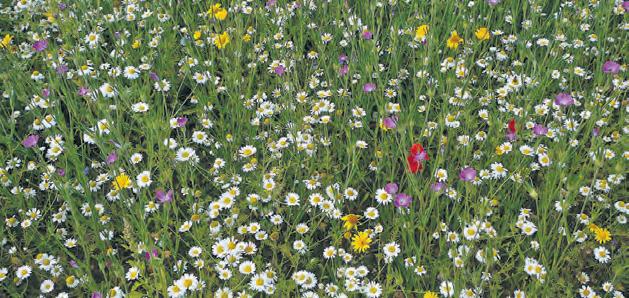
I have a new approach to my lawn. It started two years ago when I thought in principle that I would support ‘ No Grow May’ but then chickened out because I could imagine the grass getting long and wet and then it taking me weeks and weeks to cut in July.
I bet many gardeners felt the same.
My approach took a different direction.
I became fascinated by lawn weeds – pretty, tough, packed with pollen and which I think add a whole new dimension to having a lawn.

I was brought up outside of Minehead with my father’s gardening principles which was to remove weeds at all cost. My dad loved his lawn, took great pride in it and had his mower blades sharpened to perfection so the lawn was regularly shaved down to an inch of its life and then fed with a whole range of fertilisers which must have cost him a lot of money, as my memory is he applied lots and lots of it in spring , summer and autumn.
In May and June my memory is he cut it every two days!
It was green. It was stripped and it was perfection.

We were not allowed to play cricket or football on it and were banished to the nearby bumpy field for play.
As I say, I have a different approach which were he still with us would shock him. I have let the weeds grow in my lawn and have a much more relaxed approach to mowing.
If you put your desires to be neat and tidy to one side and lock away the fertilisers, lawn feeds and sprays then a lawn will give you lots and lots of rewards you probably didn’t expect.
Above and beyond the traditional striped classic green swathes we known from our childhood, you will soon have as I now enjoy, a long flowering wildlife free lawn.
Many drought resistant native plants are allowed to flourish, staying greener during the heat of last summer. Clover is in abundance in my lawn which has nitrogen fixing roots, reducing mowing allows taller flowers and grasses to bloom and the whole effect is stunning.
So in my lawn I now enjoy:
Daisies which flourish from early spring to late autumn.
Yarrow, white/pink flowers which appear in May and seem to last the whole summer.
White clover clusters of lovely white flowers which grow stronger and more dramatic as the season progresses.
Prunella vulgaris or Selfheal ,purple and colourful, appears in flower in June. Dandelions, wonderful and colourful and a magnet to insects – who could think of them as weeds?
I think the role of our lawns has changed and thank goodness for that. It now has a role to play as a flower studded alternative which is great for the environment and for insects. Long may that continue and long may we put away the mower for long periods.
“If you put your desires to be neat and tidy to one side and lock away the fertilizers, a lawn will give you lots and lots of rewards you probably didn’t expect”
If you are looking for a gardening day out to enjoy over the next few weeks then the south west is a dream come true.
It offers so many opportunities at a time of the year when garden lovers look forward to getting out and about and indulging their passion. And the prospect of finally warm settled weather is a bonus.
Private gardens will be at their best as May moves into June with many roses in full glory and colourful borders galore tempting garden lovers. The list of things to do probably reaches its peak over the next few weeks with gardens open, village fetes and fairs, plant shows, county shows and plant sales.
We have again rounded up some idea of places to visit, things to do, events to take part in so you can make the most of what promises to be a sensational June.

Cornwall’s best kept secret: a hidden valley hotel with its own secluded beach, Hotel Meudon is a coastal paradise near Falmouth, Cornwall.
The stunning hotel is a stylish retreat boasting nine acres of sub-tropical gardens, stunning sea views, 29 bedrooms and a treatment room. Award winning Restaurant Meudon, The Drawing Room and Freddie’s Bar are open to all, whether you’re staying at the hotel or simply passing by. All menus feature dishes created using Cornwall’s bountiful larder.
A stay or visit to Hotel Meudon this summer offers you time to unwind, whilst enjoying our stunning gardens and top-quality service. www.meudon.co.uk


The gardens of the historic Badminton House, home to the Duke and Duchess of Beaufort are opening on Sunday, 25th June and Sunday, 3rd September. There will also be a variety of local stallholders selling plants, flowers, hot food, coffee and cakes in the West Courtyard. The event will support the Severn Area Rescue Association (SARA) who will have volunteers on site and The Badminton Church Restoration Fund.
Tickets are £10 pre-sale or £12.50 on the day. Children under 12 go free. Gates open from 10am with last entry at 4pm. Visit www.badmintonestate.com
Badminton House, South Gloucestershire, Badminton GL9 1DD
Set in a beautiful valley in the heart of North Devon, the 65 acre haven of biodiversity that is RHS Garden Rosemoor has something for everyone.
You can explore the famous ‘garden rooms’, each themed to celebrate the seasons in different planting styles and designs, where the plants are always the star.
Luxuriate in the scent of over 250 rose varieties in our two dedicated gardens, at their fragrant peak in June.
Experience a blaze of colour and vibrant plants in our Hot Garden or unwind in the soothing pastels and blues of our Cool Garden, a tranquil oasis with a teardrop-shaped pond. Discover trees from every continent of the Northern Hemisphere, see our rare heritage apple orchard or be inspired by our Fruit and Vegetable Garden.
Families can let their imaginations run wild exploring our woodland walks – try your hand at den making or follow our leaf rubbing trail. Make sure to check ‘what’s on’ before your visit!
www.rhs.org.uk/gardens/rosemoor 01805 624067
rosemooradmin@rhs.org.uk
RHS Garden Rosemoor, Great Torrington, North Devon, EX38 8PH
CARAVAN & TOURING PARK
BOSCREGE CARAVAN & TOURING PARK
THE MOST PICTURESQUE CARAVAN PARK IN CORNWALL
With a welcoming atmosphere and set in 12 acres of Cornish countryside only two miles from the beautiful sandy beaches of Praa Sands, Boscrege Caravan & Touring Park is the best place to enjoy your Cornish holiday.
Each of our luxury holiday homes comes with a private garden and Wi-Fi. Perfect
for families and couples, we are open all year, and offer seasonal pitches.
We offer the following:
• Designated dog walking fields
• Pet friendly accommodation


• Comprehensive storage
• Luxury holiday homes for sale
01736 762231 • enquiries@caravanparkcornwall.com www.caravanparkcornwall.com

About 25 Private Gardens Open 17th & 18th June, 2-6pm
Day ticket to all gardens £8

Ticket for 2 days £10 Accompanied children free Open Gardens Teas served from 1pm Well stocked plant stall from 1pm Free Car Park (DT2 7GD) from 1pm Equal proceeds to: The Charles North Charity & The Dorchester Food Bank
Keep up to date: www.cerneabbasopengardens.org.uk
Think sunshine, flowers and cake!

Gather
ngs.org.uk/gardenparty

4th June
High Glanau Manor, Nr. Monmouth
NP25 4AD

11th June

Waterperry Gardens, Nr. Oxford OX33 1JZ
www.rareplantfair.co.uk


Please visit our website for full details of admission fees and times of opening.

ENJOY THE EXCEPTIONAL BEAUTY OF THE HARTLAND ABBEY VALLEY IN JUNE



Visit this fascinating house with its stunning architecture and collections. Exhibitions. Beautiful walled and woodland gardens and walks to the beach.
* Dogs welcome * Holiday Cottages * * Delicious light lunches & cream teas * * Hartland Quay 1 mile *
House, Gardens, Exhibitions etc and Café until 5th October
Sunday to Thursday 11am - 5pm (House 2pm - 5pm last adm. 4pm)
NB: Main reception rooms closed 12th – 29th June for filming. For more information and special events see www.hartlandabbey.com
Hartland, Nr. Bideford EX39 6DT 01237441496/234
About 25 private gardens in Cerne Abbas will be open from 2pm until 6pm on Saturday, 17th and Sunday, 18th June. This is the 47th time that this event will take place and the proceeds will be divided between a cause in the village and another outside; this year the Charles North Charity set up in 1943 to help folk in distress in the village and the Dorchester Food Bank. Entrance to all gardens is by a single ticket which costs £8 for adults and accompanying younger folk under 16 are free. A few gardens are accessible on wheelchairs and most gardens accept well behaved dogs on leads. There is a well-regarded plant stall and teas are provided by the local Youth Club, both commencing at 1pm. Almost all the gardens are within easy walking distance of the free car park and are located on maps distributed with the ticket. More information at www.cerneabbasopengardens.org.uk


There were one or two casualties amongst the roses with the heavy frosts over the winter but these have all been replaced so there are now well over 40 varieties for you to see at Cadhay in Ottery St Mary. The allotment holders have been busy in their plots and the fruits of their endeavour is very much in evidence in June. We have made a big effort to clear the medieval fishponds of bullrushes which seemed to be flourishing all too well so the ponds will once again be resplendent with water lillies and hostas.
Cadhay is open on Friday afternoons throughout the Summer from 2pm.
Contact jayne@cadhay.org.uk or 01404813511
Cadhay, Ottery Saint Mary EX11 1QT
The arrival of early summer in the gardens and walks at Hartland Abbey is a wonderful time to visit and to relax in the valley chosen by Augustinian monks in the 12thC to establish their monastery, only one mile from Hartland Quay on the spectacular Atlantic coast. Their Abbey, since 1539 a family home, is a fascinating trawl through family history, both local and national. A wander to Blackpool Mill on the coast, sitting in the shade with a good book or seeing the 18thC Walled Gardens bursting into their summer glory, is an escape from modern life. Exhibitions and displays - ‘Filming since 1934’ ‘William Stukeley, Saviour of Stonehenge’ and more are included in garden ticket. Old Kitchens tearoom produces delicious homemade lunches and cream teas! Dogs are made very welcome!
The main reception rooms will be closed for filming between 12th and 29th June. Hartland Abbey, Hartland, Nr. Bideford, N. Devon EX39 6DT. 01237441496/234 www.hartlandabbey.com for all details.
Long warm sunny days entice the herbaceous plants to flower with multicoloured Candelabra Primulas snaking along the stream and around the lakes. By the end of the month, they are joined by gorgeous drifts of two National Collections; Japanese Iris and Astilbes which won a Gold Medal at the prestigious Hampton Court Flower Show last year.
The herbaceous borders are aglow with colour, and the Mediterranean border in front of the tea-room provides a visual feast to view while enjoying a delicious cream tea.
Alpines planted along the scree-bed continue to provide an amazing contrast of foliage and flower while above creamy Cornus Kousa flowers burst into bloom.
Visit the plant sales for unusual, as well as the tried and tested plants.
www.marwoodhillgarden.co.uk Tel: 01271 342 528
Email: info@marwoodhillgarden.co.uk
Marwood Hill Gardens, Nr Guineaford, Barnstaple, North Devon, EX31 4EA
Boscrege Caravan and Touring park in Cornwall is a peaceful and picturesque park, set at the foot of Tregonning Hill, Godolphin National Trust and amongst tranquil Cornish lanes in an area of outstanding natural beauty. The park, open all year is close to the Cornwall coast and a few minutes’ drive to Praa Sands, one of Britain’s nicest beaches. So, if you are looking to take a luxury holiday (doggie friendly with dog friendly homes and on-site designated fields for the dogs too) in Cornwall in a either a self-catering caravan, lodges touring or even purchasing your very own holiday home then contact Boscrege Caravan and Touring Park.
Boscrege Caravan Park, Boscrege, Ashton, Cornwall TR13 9TG Tel: 01736 762231
www.caravanparkcornwall.com
The Bishop’s Palace in the heart of Wells are preparing for another busy couple of months. The 14 acres of tranquil gardens in the heart of medieval Wells will be hosting a series of spring and summer events for the family. The focus of course remains the stunning gardens in the heart of Wells.
You can wander along and around the many herbaceous borders, savour the scent of roses in the parterre, admire the beautiful views of the gardens, moat and further afield from the top of the ramparts.
Over the years the gardens have changed as successive bishops have added their legacy and today these gardens have Grade II listed garden status due to their historic nature.
In 2016, the gardens were acknowledged by the Royal Horticultural Society, by being made a “Partner Garden”. Entry is free most Fridays to RHS members with starred cards. This offer is not valid on certain event days so please check the website for details where you can also find details of all the summer events being held there.

Bishop’s Palace and Gardens, Wells, BA5 2PD www.bishopspalace.org.uk
Country Gardener
The link between gardens and our health has never been more relevant. The beneficial effects of spending time in a garden, whether your own or someone else’s, include peacefulness, solace and inspiration. And time outside, surrounded by the beauty of nature triggers natural endorphins that make us feel happy. Scientific studies have also shown that spending time in a garden can reduce blood pressure and the stress-related hormone, cortisol.
Knowing that gardens really are good for you makes visiting a National Garden Scheme garden the perfect day out, and you’ll be supporting some of the UK’s bestloved nursing and health charities too.
Find a garden near you: ngs.org.uk
GARDENS & TEAROOM
Open every Friday 2pm - 5.30pm from 5th May to 29th September
Also last weekend in May & August Bank
Holiday weekend - Sat, Sun & Mon
GARDENS: adult £5, child £1
CADHAY, OTTERY ST. MARY, DEVON, EX11 1QT 01404 813511 www.cadhay.org.uk Member of Historic Houses

We produce and grow the largest selection available in the UK. Plants are pot grown and suitable for garden, patio or bonsai.
Visitors welcome Mon-Sat 9am-1pm & 2pm-4pm
Barthelemy & Co (DCG), 262 Wimborne Rd West, Stapehill, Wimborne, Dorset BH21 2DZ
Tel: 01202 874283
enquiries@barthelemymaples.co.uk
www.barthelemymaples.co.uk

• Floral Tours are working in partnership with Country Gardener to offer readers two tailored tours for 2023: The Monet and Versailles
Experience 18 - 22 June 2023, 10 - 14 Sept 2023
The Delights of Yorkshire
9 - 13 July 2023
If you would like to join us on these tours please call Pat at Floral Tours.
• UK Garden Tours and Events




We have programs for UK tours and events that we can tailor to your club preferences if this is your choice please give us a call
Discover



SUNDAYS 25TH JUNE AND 3RD SEPTEMBER 2023
10AM-4PM

ADULTS £10 PRE-SALE OR £12.50 ON THE GATE SENIORS £7.50 PRE-SALE OR £10 ON THE GATE CARERS AND CHILDREN UNDER 12 GO FREE
Tickets and full information available through the website: www.badmintonestate.com
Any questions please contact the Estate Office on 01454 218203 or by email estateoffice@badmintonestate.com



Home to four National Plant Heritage collections, this private valley garden spans over 20-acres and showcases three stunning lakes, rare trees & shrubs, and colourful surprises throughout each season. Not only a haven for wildlife, the garden is also the perfect environment to explore and be inspired. Enjoy a day of inspirational and relaxation for the whole family.
Catch up over coffee and homemade cake or a cream tea in the picturesque Garden Tea Room or take a bit of Marwood magic home with you from our Walled Garden Nursery and Plant Sales.
Enquiries & Tea Room 01271 342528
Plant Sales & Nursery 01271 342577
e info@marwoodhillgarden.co.uk w marwoodhillgarden.co.uk
Marwood Hill Gardens, Marwood, Barnstaple, Devon EX31 4EA
Explore 14 acres of RHS partner gardens, moat and medieval Palace in the heart of historic Wells, Somerset

Group visits welcome with Tour Packages available (including Senior Gardener's Tours)
ADMISSION: 12 months of return visits on any normal sightseeing day or special Groups rates available
Plan your visit at: www.bishopspalace.org.uk

There are two Rare Plant Fairs taking place during June, both held in interesting and unique gardens with their own individual style, making a summer visit to one (or more!) of the events a great day out for all gardeners. A fabulous selection of specialist nurseries attends each of the Fairs, all of whom are experts in the plants that they grow. The full programme is:
HIGH GLANAU MANOR near Monmouth, Sunday June 4th, from 11am to 4pm. These beautiful Arts and Crafts gardens have been lovingly restored by the present owners and offer spectacular views over the Vale of Usk.



WATERPERRY GARDENS, near Oxford, Sunday, June 11th from 10am to4pm. The former teaching gardens at Waterperry have now been transformed into stunning ornamental gardens at this iconic venue, including a rose garden, formal knot garden and a canal studded with waterlilies. Visit www.rareplantfair.co.uk for full details of the events, including admission charges and a complete list of the exhibitors attending each one.
Barthelemy & Co near Wimborne in Dorset was established by a French nurseryman almost a century ago and the Skinner family now specialise in propagating and growing acer palmatum – or Japanese maples as they’re known. Throughout spring, summer and autumn the delicate foliage of the acer presents exquisite shadings of Mother Nature’s gold, pink, purple, green, yellow, orange and red. Acers are a delightful addition to anyone’s garden, giving an aura of peace and tranquillity. The ten-acre nursery at Stapehill has a huge collection of Japanese maples to choose from and expert staff are on hand to help select the right variety and to offer advice. Over 100,000 acers are produced at Barthelemy and Co every year approximately 15,000 - 20,000 of them are grafted named palmatum varieties, as one of the largest specialist growers of their kind. Telephone 01202 874283.
www.barthelemymaples.co.uk
Well known for its magnificent mixed borders and Lutyens influence, the Garden at Miserden is a timeless 17th century walled garden still retaining a wonderful sense of peace and tranquillity. Returning for June and July the garden will be hosting the magnificent Cotswold Sculptors Association Creating Spaces Exhibition with over 120 sculptures on display plus an indoor exhibition in the quaint Club Room in the centre of the village. The garden’s vintage Glasshouse Café, a lovely setting to enjoy lunch or a piece of cake after exploring, will also be hosting several events throughout the year.
www.miserden.org

The Garden at Miserden Near Stroud, Gloucestershire GL6 7JA
THE QUALITY OF YOUR FRUIT AND THE SUCCESS OF CORDON AND ESPALIER TREES CAN BE VASTLY IMPROVED WITH ASTUTE LATE MAY AND EARLY JUNE PRUNING
The basic principle about pruning your fruit trees is a simple one. It should be done when the tree is dormant and before it starts growing again (bud burst) which is normally between November and early March. However, the importance of back up pruning in summer and in June is now establishing itself.
Summer pruning is concentrated on fruit trees, especially well-established ones. A few simple, well-placed cuts can improve fruiting and limit the size of the tree, ensuring it stays compact enough for a small garden.

Standard apple trees - those with a central trunk - should be pruned when the tree is dormant in winter. Ideally between November and early March. But the summer months are important to ensure maximum crops for trained apple trees, like espaliers and fans, which all should be pruned in summer.
In general, pruning of apples (Malus species), pears (Pyrus species) and quince (Cydonia oblongata) is best carried out in winter. Quince fruits are produced on the new season’s growth so winter pruning can be used to promote new shoots and a better fruit crop. When you're pruning, aim to create an open goblet shape in the canopy. Only remove about a third of the branches, including those that grow towards the centre of the goblet, crossing, diseased and damaged branches. This will encourage new growth and allow the air and sunlight to penetrate the branches.
Trained fruit trees and or overgrown trees can be pruned in the summer to maintain shape. Summer pruning of apple and pear trees allows sunlight to ripen the fruit and ensures good cropping the following year. This is the main method of pruning for restricted forms such as cordons, espaliers, fans and pyramids.
Pruning in summer of trees and shrubs is usually done to promote fruiting or flowering in this and the following year. Summer pruning limits growth and focuses energy on fruits or flowers.
This sort of pruning is important but needs to be selective Few plants are pruned this time of year because pruning encourages new growth that does not have time to harden off before winter. Late-season pruning typically does more harm than good.
A lot of the focus on summer pruning is on stone fruits or if your tree is too big, and you don’t want to encourage vigorous growth. It is also essential for trained apples and pears where the key task is to make sure the branches are trained, secure against a wall and not producing too much underdeveloped fruit.
It doesn’t trigger the tree into producing lots of new growth so it's good for trees you want to keep small and for dwarf trees. It’s also a chance to remove diseased or dead wood. Because summer pruning is carried out after the tree has started to develop fruits (known as setting fruits), you can avoid cutting the branches with fruits on.
Once plum trees have established (about three years old) they can be pruned in summer, from June onwards.
Plum trees, along with cherries, peaches and apricots are all plants from the genus Prunus and are best pruned lightly in the summer. Carefully prune out the centre of the canopy to create an open goblet shape. Only take about one-third of the branches out and remove crossing ranchers and those growing inwards towards the centre. Also, remove any shoots or buds growing from the base of the trunk.
Summer pruning encourages your tree to produce higher fruit crops, allows the air and light into the centre of the tree canopy, which helps fruits to stay healthy. Prune in late May, either before or after flowering and remove damaged, dead and diseased branches and focus on keeping the tree a manageable shape and size. Make cuts to where there is fruit.
If you’re lucky enough to have a mature mulberry tree it won’t need much pruning. It may however benefit from pruning when it’s clear the tree can’t support itself because of the weight of the fruit .
Only prune lightly or you’ll shock the tree into so much growth it may not be able to support itself. Mulberries also tend to bleed sap from cuts, which is minimised in winter.
Sofia Walfen is passionate about trees. From her home in Gloucester, she works for the Forestry Commission and her day-to-day job brings her in contact with enthusiastic gardeners who are keen to plant more trees
This is a plea for gardeners to keeping planting more trees. Every year in every way possible.
I should say how much I look forward to your magazine.

It fits in so well with my work and perhaps more important it forms a link I increasingly enjoy with gardeners, whether it is through Forestry Commission work, talks to garden clubs or day to day meetings.
Gardeners, I am proud to say have a wonderful passion for trees, for the need to grow more of them and care for them and understand them.
The fact is we have just three decades to reach net-zero emissions and tree planting has emerged as a prominent part of this country’s plan to get there. Trees are for now the only strategy we have and my work with the Forestry Commission brings me in touch with gardeners and gardening organisations who have all the enthusiasm in the world to plant and care properly for more and more trees come with additional benefits for wildlife, flood management and health.
There is huge strong public support for tree planting to tackle climate change. This was evident during the last general election, when parties competed to produce ever-more ambitious afforestation targets.
The recent budget saw then Chancellor Rishi Sunak announce a forest “the size of Birmingham” across England, a contribution to the wider UK target to plant 30,000 new hectares every year.
The evidence is clear however that even if tree planting meets its highest potential for carbon storage, it would only offset a small fraction of the UK’s current and future emissions, meaning efforts to dramatically reduce fossil fuel use should remain top priorities.
Tree seed is a key, but often overlooked part of tree production. With the ambitious tree planting commitments, and the introduction of legally binding targets to increase tree and woodland cover in England to 16.5 percent by 2050, demand for trees and therefore tree seed is more important than ever. That’s why last year the Seed Sourcing Grant was launched to enhance the quality, quantity, and diversity of tree seed sources in England. Understanding the ‘why’ behind why forests and woodlands and trees in general are so good for our mental health and wellbeing is just as important. We’ve improved our knowledge and evidence base of all this.
The Government has targeted 30,000 hectares of new planting per year in just over two years. With less than half the goal currently achieved, many more saplings need to take root. So how will we do it? The National Forest may have a blueprint.
Over a 200 square mile patch of the Midlands, a transformation is taking place. Across a landscape once scarred by coal mining and industrial manufacturing, a new forest is thriving. Since 1990, when the first saplings were planted in the National Forest, forest cover has increased from six to 22 per cent.
The ultimate aim? For one third of this area to be made up of forest habitats by 2045. That equates to over six million more trees – or around 250,000 planted per year. But how feasible is that?
It’s a task that’s part of a larger, UK-wide target: to plant over a hundred square miles of trees per year – that’s 90-120m of them – by 2025. I write about this because it is an inspirational idea but there will be more. Currently, only about 13 per cent of the UK is forested.

But it’s not as simple as just planting more trees everywhere – the right types need to be planted in the right place. That might mean growing more
fruit trees or hedgerows as part of farmed landscapes, creating woodlands alongside new housing developments, or more native deciduous trees in parkland that urban communities have access to.
We’re doing much more than just planting trees – we’re creating hope and aspiration. We’re creating an identity of a forest – that’s not just a visual thing or an ecological thing. That’s the emotional pull – people can feel part of something exciting and they can associate culturally with the nature of this place.”
The momentum being built in the National Forest is part of a nationwide drive to regenerate landscapes and integrate biodiverse, climate-resilient habitats into both rural and urban communities. As part of the UK government’s Nature for Climate fund, the Department for Environment, Food and Rural Affairs (Defra) has pledged £12.5m over five years to the National Forest. Now in the third year of this funding pledge, the money is supporting the organisation’s ongoing tree-planting activities.
This is of course only one exciting part of what we need to do. There are so many schemes now being funded by charities and commercial organisations to provide a route for gardeners to be able to afford or even claim for free trees to plant in their own gardens. Whatever we do at the level I work at for the Forestry Commission then so much more will be achieved if gardeners accept what we are trying to achieve to do and join in and help us.
Plant a tree this autumn.

Plant it for the birth of a child, plant it for an anniversary, plant it to commemorate a new garden.
Plant it in memory of a loved one.
If we can get this into the psyche of people who love their gardens our campaign to fight back for the environment and rebalance our carbon footprint will be something we can achieve with ease.
Peter Galthorpe is an inspiration for his fellow allotment holders in Devon when he champions the cause of reuse and recycle for all sorts of items he finds a novel use for
Many gardeners are very creative people. One man’s trash is another gardener’s treasure. So, I am known as someone who strongly believes that you can use common household items that would otherwise be destined for landfill to add style and flair to your garden.
If you want to start ecological gardening start with your seeds and seedlings. Every year, and this one has been no different, garden centres fill their shelves with all manner of plastic containers to appeal to the gardener. However, buying them is such a waste considering there are so many things you can use from your own home.

Rather than buying something new, reuse the old and try one of the following.
EGGS AND EGG CARTONS You can plant your seeds and seedlings into empty eggshells or cardboard cartons. Cardboard options can be planted directly in the garden when your seeds are grown and you therefore avoid disturbing fledgling root systems. As well as being compostable, egg boxes are the perfect containers for chitting potatoes. Simply pop your potatoes in with the eyes upright.
PAPER CUPS You’ll need to poke a small hole in the bottom for drainage, but these are perfect for slightly bigger seedlings.
I’m having a bit of a down on plastic on the allotment but one thing I will still go on using are PLASTIC BOTTLES where you just cut them in half and use for a whole of range of recycling ideas. By cutting them in half they become mini greenhouses for big and small bottles.
Cutting off the bottom of large clear plastic bottles makes an excellent mini-cloche which will protect seedlings from harsh winds, slugs and snails. Leave the top off the bottle so that it can breathe without excess moisture and heat building up (a recipe for mould). Once the plants are touching the sides, the bottle should be removed.

On our allotments, old WHEELIE BINS are prized possessions – a couple of holes drilled in the right places and they easily become sturdy water butts or compost bins.
They’re also cheap, dry storage for plant pots, canes, plastic sheeting and netting, and woodchips. At home, I use old BINS for storing my chicken feed and my in-laws use them, with an access hatch cut in the bottom, for storing firewood and multifuel.
Gardeners and allotmenteers are always resourceful types when it comes to reusing and recycling stuff – I don’t think I’ve ever met a grower who doesn’t keep ICE CREAM /MARGARINE TUBS etc for reuse – but I thought it would be worth having a bit of a
sharing session about what you reuse for starting seeds, as plant pots or as water-catchers under plant pots, and if there is anything that you choose not to reuse for whatever reason.
At one point, a good few years ago now, I think about 90 per-cent of my seeds were started in PLASTIC MUSHROOM TUBS — either directly in the tub or using them to catch water draining from plants pots. In the past, I also used shallow FRESH PASTA PACKAGING as starter trays and multiserving YOGHURT/CREAM POTS for the growing on stage.
Build a compost bin from PALLETS. It is so simple – you just use four pallets on their edges for the sides, held together with some strong garden wire twisted with pliers. Don’t worry about the gaps –compost needs air and it will usually be held in place by the pallet slats which should face inwards. I have successfully built a compost heap inside a raised bed using this method which has the advantage that any nutrients washed through by rain still end up in the soil. Then in spring the pallets are removed and the resulting compost is spread over the bed for the next season.
BATHTUBS, SINKS AND BUCKETS These make excellent ponds when sunk into the ground. With a little care you can cultivate a rich ecosystem in your pond and attract frogs and toads which will then prove very effective at reducing the numbers of slugs on your plot. Add some pond weed to keep the water clean together with old LOGS OR PIECES OF WOOD which the frogs can use to climb out, as recycled tubs tend to have very slippery sides. Finally, don’t forget to make the pond safe if children are going to be around: either fence it off or cover it with a metal grid.
A GUTTER GARDEN is a way of making good use of the vertical space in your garden and is ideal for concealing an unattractive area of fence. Also your old gutters are being repurposed rather than ending up in landfill. Drill a few holes in the bottom and you can stack them parallel to make an allotment display more attractive. A gutter garden is great for growing herbs, microgreens or strawberries.


Shade is important in a garden but that doesn’t mean you need to go and buy something new, A VINTAGE LADDER will provide excellent support for climbing or trailing plants.
Hopefully, this list planted a seed you can grow into your next repurposed garden project.

When it comes to garden ideas and any sort of self sufficiency, recycling means minimal expense and the feel-good factor of doing your bit for the future of the planet too.


Gardeners need all the help they can get during these hectic weeks of May and June when suddenly everything is green and growing. There’s not enough time to do everything which is needed. So, it’s important to get some help. There are so many products s lined up now to take off the hard physical work in the garden that most of us would be crazy not to seek help. And then there’s the opportunity of when shopping around to treat ourselves to a little luxury item. At Country Gardener we are always on the loot out for great products and fresh ideas so here’s a few to help take the strain.

The new growing season offers lot of challenges to gardeners - none more than keeping fast growing shrubs and climbers under control and well staked.


One great idea is using Rivelin Glen Products which are well designed wire anchors. They are quick and easy to attach to concrete posts (without drilling) to act as an ‘eye’ by threading wire through them to create a trellis system.
The Gripple Trellising System is ideal to use with these Wire Anchors as the wire does not stretch, takes up to 100kg load and has a life span of 15 years. You can achieve multiple rows with one length of wire and two tensioners so it’s no more sore hands or sagging wires.
Rivelin Glen Products are the main stockists of the Gripple Trellising System. Wire Anchors cost from £10 a pack of three. Gripple starter pack £19.75p


COIRPRODUCTS
Spring/Summer 2023
Spring/Summer 2023
Spring/Summer 2023
Spring/Summer 2023
Vegan CertifiedAll Natural100% Biodegradable Peat-Free
Vegan CertifiedAll Natural100% Biodegradable
Vegan CertifiedAll Natural100% Biodegradable
Peat-Free
Vegan CertifiedAll Natural100% Biodegradable Peat-Free
Peat-Free
From £12.98
From £12.98
From £12.98
From £12.98
Give your plants the perfect home with our top-quality Hanging Baskets and Basket Liners. Crafted from the finest Coir Fibre and Jute Yarn, this product is perfect for adding a touch of charm to any indoor or outdoor space.
Give your plants the perfect home with our top-quality Hanging Baskets and Basket Liners. Crafted from the finest Coir Fibre and Jute Yarn, this product is perfect for adding a touch of charm to any indoor or outdoor space.
Give your plants the perfect home with our top-quality Hanging Baskets and Basket Liners. Crafted from the finest Coir Fibre and Jute Yarn, this product is perfect for adding a touch of charm to any indoor or outdoor space.
Give your plants the perfect home with our top-quality Hanging Baskets and Basket Liners. Crafted from the finest Coir Fibre and Jute Yarn, this product is perfect for adding a touch of charm to any indoor or outdoor space.



From £7.19 From £17.99 From £3.98
From £7.19 From £17.99 From £3.98
CoirCoins Pestle & Mortar CoirDiscs
From £7.19 From £17.99 From £3.98
CoirCoins Pestle & Mortar CoirDiscs
From £7.19 From £17.99 From £3.98

CoirCoins Pestle & Mortar CoirDiscs
FOR 10% OFF USE CODE: COUNTRYGARDENER
CoirCoins Pestle & Mortar CoirDiscs

FOR 10% OFF USE CODE: COUNTRYGARDENER
FOR 10% OFF USE CODE: COUNTRYGARDENER
FOR 10% OFF USE CODE: COUNTRYGARDENER

Online Shopping: www.coirproducts.co.uk
Online Shopping: www.coirproducts.co.uk
Online Shopping: www.coirproducts.co.uk
Online Shopping: www.coirproducts.co.uk







With its uneven ground, varying levels and soft as well as hard ground, the garden presents a challenge an ordinary ladder just isn’t able to cope with.



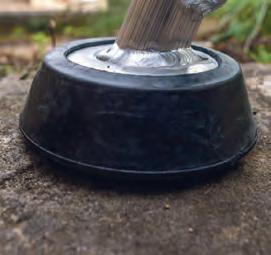
A HENCHMAN Tripod Ladder is designed to keep you safe, stable and secure. The increased stability helps give you the confidence at height and makes tasks like hedge trimming and tree pruning easier and more enjoyable too. No wonder many of our customers wish they’d bought one sooner!

The HENCHMAN Tripod Ladder’s lightweight design makes it a joy to use and carry – perfect for those hard to reach jobs around the garden and the home.


Each of the ladder’s three legs can be adjusted individually for complete stability on uneven surfaces.
The built-in working platform and high guard rail enable you to work hands free with ease.
The ladder’s claw feet stop sudden sinking on soft ground, the free rubber feet keep you stable on hard surfaces indoors and out.

PRICES FROM £279 • SIZES 6-16FT
FREE DELIVERY • 5 YEAR WARRANTY



(WORTH £25) Simply add to order and apply promo code CG623 in basket
4.9
THE HENCHMAN TRIPOD LADDER’S UNBEATABLE SAFETY FEATURES INCLUDE:
on over 3,000 reviews

SEE FOR YOURSELF!

Scan here to learn more about the full range of Henchman Ladders


TO ORDER OR FOR MORE INFORMATION VISIT

“Well made product that inspires confidence at heights!” Daniel. G Based

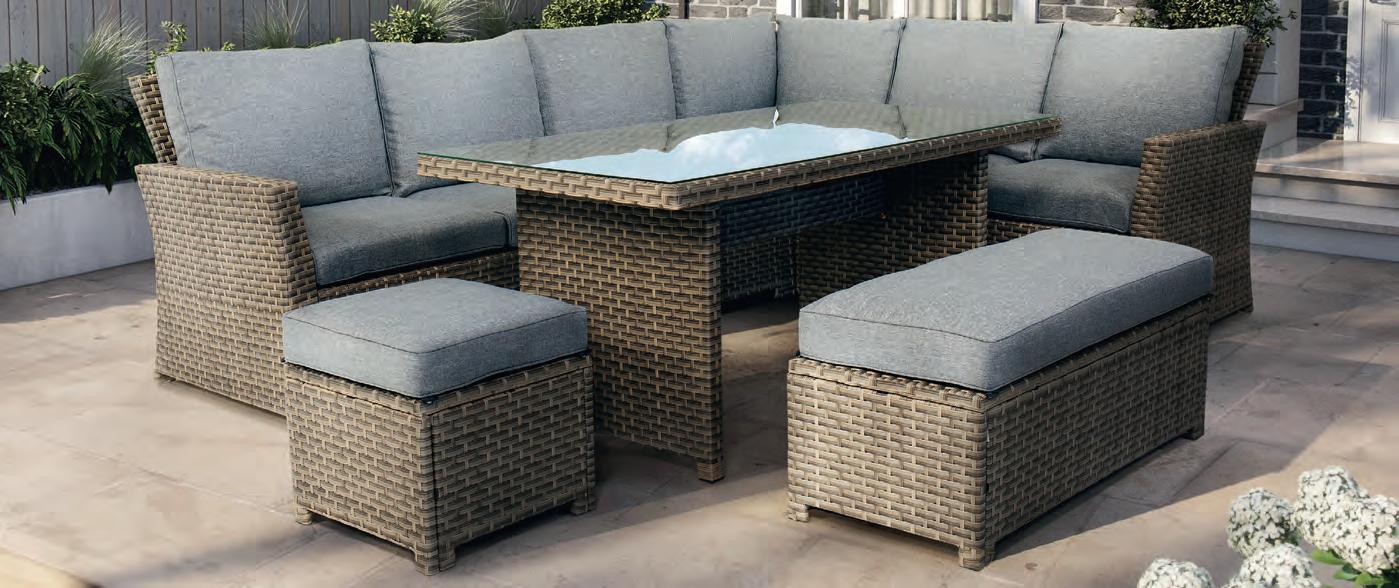




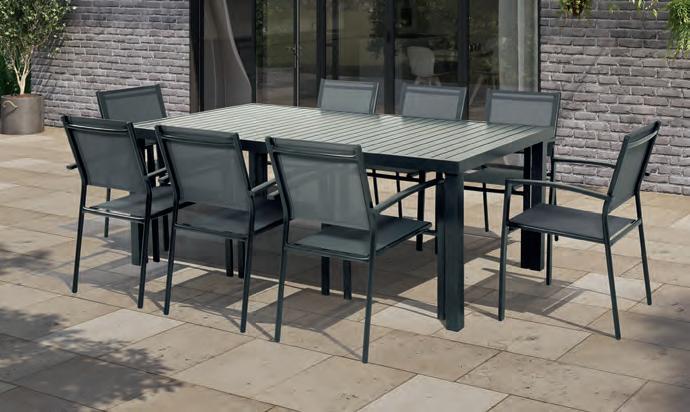













‘QR’ (Quick Return) compost activator has been helping gardeners make compost and improve the health of their soils since the early 1930’s. Invented by Maye Bruce, one of the founder members of the Soil Association, ‘QR’ became popular all over the world until the 1970’s.
Made from a blend of dried herbs, ‘QR’ speeds up the decomposition of organic matter. There is no turning required and compost can be made in as little as 4 weeks. It is suitable for use with garden or kitchen waste in all types of compost bins.
‘QR’ is easy to use – simply add water to the powder and apply to the layers of the heap during its construction.

Available from Exedra Nursery, Stroud Tel: 07487 537026 and online at Gardener’s Cottage Plants www.gcplants.co.uk or Tel: 01434 672594)
The Princess 38 Li battery powered lawnmower features in the Mountfield freedom500 range. With a 38cm cutting width, 860W brushless mower and integrated rear roller and front comb the Princess 38 Li is a superb battery powered mower suitable for small to medium sized lawns.
The innovative freedom500 range really does make gardening easy with all the power of petrol but the convenience of cordless. The smart ePower batteries are able to adapt to the tool they are fi through a smart ID microchip and the battery management system on the mower or garden tool - providing the best performance and efficiency, regardless of whether you are cutting the grass or cutting the hedge.
Customers say that it is easy to manoeuvre, simple to clean and offers great value for money. It has just been chosen as a Best Buy in a national newspaper, for best lawnmower for small gardens…with a super stonking 10/10!
The Princess 38Li is available now at www.mountfieldlawnmowers.co.uk

Make the most of your garden this summer and really relax in style. The Chesterton corner sofa and matching glass-topped coffee table set is perfect for entertaining or spending long evenings outdoors. Generously proportioned with deep, anti-fade cushions you can easily seat five people in comfort. The Chesterton is not just stylish, it’s durable and easy to look after – the seat and back cushions all feature removable covers and a construction of tough polyrattan and a galvanised steel frame means that the set can even be left out all year round, making it the ideal addition to your outdoor space this year. What’s more, for a limited time this set has an incredible 60 per cent off and is sure to sell out.

The price was £1,499 now £599.60 only when you visit outandout.com or call 02037 728 752. Delivery Excluded. Whilst stocks last.

Henchman specialise in ladders with unique safety features, engineered to keep you safe, stable and secure when working at height. They are trusted by thousands of local customers including Royal households, professional gardeners and DIY enthusiasts.
Henchman’s flagship product the tripod ladder is built specifically for stability on uneven ground and allows you to tackle jobs at height with confidence. Suitable for indoor and outdoor use, the tripod’s ladder unique design features adjustable legs that can be altered to accommodate uneven surfaces, a build in working platform with guard rail that enables you to work hands free and sturdy claw feet to prevent sinking on soft ground.
Built from string and durable aluminium, this clever, lightweight ladder makes tasks such as hedge trimming and tree pruning easier and more enjoyable. Find out more at www.henchman.co.uk or call 03333007549

Enjoy
Constructed from the highest quality materials and bespoke manufactured, an Eden Veranda is a stunning addition to any home. With accessories such as intelligent heating and lighting you can spend more time ‘outdoors’ in comfort.
Every Eden Veranda is powder coated with a hard-wearing weatherproof finish, available in a choice of 56 colours and installed by our engineers.
To benefit from these offers visit edenverandas.co.uk or call 0800 107 2727 and use code CG270523. *Terms & Conditions apply, see website for details.
www.countrygardener.co.uk

Asparagus is one of the few perennial vegetables which gardeners love to grow. It isn’t surprising. Although a little patience is needed establishing the plants, once they become productive there should be a constant supply of delicious spears.
IS ASPARAGUS EASY TO GROW?
Asparagus is one of the few perennial vegetables that is commonly grown in gardens. But don't let that intimidate you - it's a relatively easy crop to grow. However, you'll need to exercise some patience when growing asparagus.
DOES ASPARAGUS KEEP GROWING AFTER YOU PICK IT?
After the end of the harvest season, allow the spears to grow. A spear is really just a plant shoot. And the shoots will grow into the mature fern that recharges the crown for the next harvest season. When harvest finishes, snap all the spears off at ground level and apply fertilisers (organic or synthetic).
HOW MANY ASPARAGUS SPEARS DO YOU GET FROM ONE PLANT?
A mature stand of asparagus plants produces spears over several weeks, up to eight weeks. During this time, a healthy plant should yield around 20 spears.

WHAT HAPPENS IF YOU DON'T CUT ASPARAGUS?
Harvesting asparagus is not mandatory, and you can leave the spears to grow into tall fern-like plants. However, if you don't harvest your asparagus, the plant will continue to grow and eventually produce berries.
WHY CAN'T YOU EAT ASPARAGUS STEMS?
We've long been told that you should bend a spear of asparagus until it snaps, and that the thick end is too tough to eat. This is not strictly true, because the spear snaps at its weakest point, and the stalk is edible and tender far below that point. The best way to judge where to cut off the stalk is by tasting it.
IS IT OK TO EAT RAW ASPARAGUS?
Asparagus is a highly nutritious vegetable that can be eaten cooked
or raw. Because of its tough texture, cooking is the most popular preparation method. However, thinly sliced or marinated raw spears can be equally enjoyable.
HOW LONG DOES IT TAKE TO GROW ASPARAGUS?
Although asparagus can be started from seed, the plants take three years to mature, so it is usually grown from one-year-old crowns. However, the plant can be productive for ten years or more, so it's worth the wait. You can start planting as soon as the soil is workable in late winter or early spring.

WHERE IS THE BEST PLACE TO PLANT ASPARAGUS?
Choose a fertile, sunny, well-drained site with soil that holds moisture well. Late spring frosts can kill emerged spears, so find an area that is not lowlying or exposed to frost. Asparagus plants have deep root systems. Avoid areas with shallow soils, or soils prone to water-saturation.

Conserving rainwater is totally free, plus it saves money on your household water bill. But the benefits don’t stop there: rainwater is particularly suited for your plants. Thanks to its unique pH, rainwater is much less acidic than water from the tap, and has higher levels of nitrogen and oxygen which helps to boost growth. The tepid temperature of rainwater is also less of a shock for plant roots than hose water.
There are plenty of different methods for collecting rainwater, ranging from the quick and easy to the more labour-intensive and more costly. The options are all designed to change the way your garden operates and to help inspire your own eco-friendly attitude when watering plants and crops.

When gardeners think of rainwater, it’s usually in terms of a free drenching in their garden and not much else. But with a few tweaks to your pre-existing garden setup, you can retain a significant amount of your area’s annual rainfall and reap the rainwater benefits for watering plants all year round.
This year the wet weeks of April and early May have provided great opportunities for storing water for the later heat of the summer. If you haven’t got your system in place whether its classic water butts, saving water into a water feature, making an underground system for more heavy-duty watering or even collecting water in old barrels then now is the time to act.
WHAT DO I DO WITH ASPARAGUS THAT HAS GONE TO SEED?
Once the asparagus has ferned out, cut the foliage back in the autumn and mulch heavily with compost to over winter. Remove the mulch in the spring and wait patiently for the delicious, tender shoots to emerge.
CAN YOU FREEZE ASPARAGUS?
Freezing asparagus is such a great way to elongate the short season, and avoid any waste. Cooking it from frozen also shortens the cooking time a little. Like most vegetables, if frozen raw, the texture, taste, colour and nutritional value of asparagus deteriorates.
Taking action now by installing water butts is a great idea, especially when you can put all that clean, fresh rainwater to good use.
Rainwater Terrace saves water for those not-so-rainy days but you also benefit from the herbs and other goodies you can grow at the same time. Save time as well as money since the taps on the drain tubes can fill a watering can in 20 seconds, twice as fast as the kitchen tap and an awful lot quicker than the tap on an ordinary water butt.
The water in a Rainwater Terrace is refreshed when it rains, avoiding stagnation, and any excess goes back to the drain or can be directed elsewhere in your garden. There’s a Rainwater Terrace setup to suit your space.
Find out more at www.rainwater-terrace.com or phone 01937 845176
how to collect rainwater in your garden is a fantastic eco-friendly way to keep your plants, flowers and vegetable crops well catered for
The popularity of garden ponds again this year has thrown more emphasis on getting the right advice and the right equipment to make sure your pond has the best chance of becoming a successful addition to your garden.
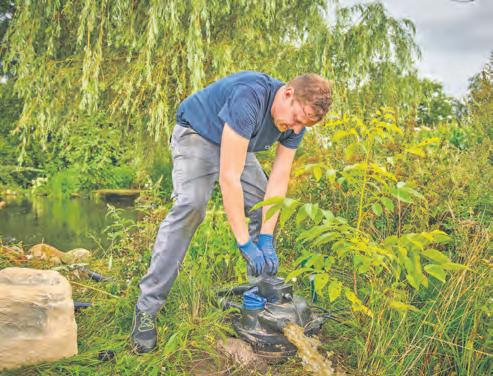





One key issue is the right sort of pump...
Pond pumps are specifically manufactured for different purposes. A pump that is intended to work on a fountain will not produce the right results if you try using it to feed your filter.
Filter pumps are designed to ensure minimal maintenance is required and they are the most
popular type of pump sold in the UK. The large holes in the casing are designed to allow dirt particles to pass through the pump without clogging it. When pumped to a filter these particles are then removed from the pond system, helping to keep your pond water clean and clear.
In contrast a fountain pump has smaller casing holes to prevent dirt from being drawn in and clogging up the fountain nozzles. The pump that you casually drop into your pond has gone through years of specialist development and testing before reaching your local store.
Find out more about OASE’s range of pumps
https://social.oase.com/pondpump
OASE COMPLETE POND SOLUTIONS
Adding a pond to your garden has never been easier with OASE’s complete pond solutions. Quite simply, we know water. Once you have decided on pond size and pond location we can provide all the items you need to bring that idea to life.
Why a pond? Ponds bring much needed relaxation and calm to a garden. The stillness of water can soothe the mind, and your pond will become a place for meditation and relaxation. Furthermore, a pond invites a whole new ecosystem of plants and animals to your garden. A pond becomes a new focal point for visiting family and guests, and is a chance for all to benefit from the beauty of water.
OASE’s technical knowledge and expertise gives you peace of mind when adding water to your garden. You should not be restricted by space or know-how. From a small pre-formed pond for local wildlife to large ponds for fish OASE products can help you.
www.oase.com
Our high quality, German-engineered complete pond solutions will give any garden a functional and attractive pond with minimal stress. We can provide liner, pumps, filtration, lighting and ways to make your pond thrive - regardless of size. Visit your local distributor for expert advice today.

VEILS
Choosing the best indoor hanging plants gives any houseplant an instant new dimension. Leafy vines and trailing stems of flowers add a touch of the tropics to interior designs with layers of texture and colour.
Light is a key issue for hanging plants so be aware of light levels needed and place plants that need sun closest to the window, with the shade-lovers further back. Some of the best indoor plants can grow quite big, and trailing plants will restrict your movement if hung in the centre of a room or hallway, so position these around the edges of your space where they won’t get in the way.
Smaller trailing plants, such as fishbone cactuses or spider plants, can be used to create a candelabra effect over a dining table or sideboard, while threading strings of small LED lights through the plant stems or shining a spotlight up into the foliage will create a beautiful shadow play.
Display the best indoor hanging plants up high. Whether you hang them from the ceiling, allow them to trail down from a shelf or display them in an on-trend hanging planter, there are plenty of ways to make them a striking focal point.

It is easy to see why this trailing houseplant is better known as the lipstick plant with its vibrant flowers set against fleshy leaves.
When they are growing in their ideal environment, lipstick plants will flower continuously. They require warm temperatures, very bright light, high humidity, consistent water, and regular fertilising to achieve this.
Lipstick Plants prefer warm environments over 65°F. As a rule of thumb, they do not need pruning. However, if some stems have become too long or bare, cut them back in spring. To do this, use a sharp knife or secateurs, leaving one third of the stem on the plant. Remove any old, dead stems as well.
Pruning encourages new, healthy stems and leaves. Each stem should be trimmed back to a length of about six inches (15 cm). Use sharp scissors or hand pruners and make a cut right above a leaf.
They are versatile—and their lovely vines can grow multiple feet long. The scientific name for a lipstick plant is Aeschynanthus (genus) radicans (species).

HEARTS ON A STRING (CEROPEGIA LINEARIS)
Long, thread-like stems dotted with tiny green and cream heart-shaped leaves, purple beneath, will twinkle like Christmas decorations as they catch the sun. Pink and purple tubular flowers add to the show in summer. This pretty plant is one of the best low maintenance indoor plants as it's very easy to grow, requiring little water and almost no irrigation over winter.
You can give it a half-strength balanced liquid fertiliser once a month in spring and summer but it will sail on regardless if you forget. Display it in a sunny room where the long stems, which can reach over 6ft (1.8m), will not trail on the floor.
SPIDER PLANT (CHLOROPHYTUM COMOSUM)
With its graceful fountain of green and white striped leaves and baby plantlets dancing on slender, arching
stems, the spider plant is a must-have addition to any plans to hang houseplants.


This is also one of the easiest to care for, thriving on neglect and happy in filtered sun or shade. Water it when the top of the compost feels dry and apply a balanced liquid fertiliser once a month from spring to autumn to keep it in peak condition.
This leafy plant grows to about two feet by one foot (30x60cm) in height and length, and is best displayed where the baby ‘spiders’ can form a skirt around the mother. The baby plants can be propagated to get more free houseplants.
MISTLETOE CACTUS ( RHIPSALIS BACCIFERA)
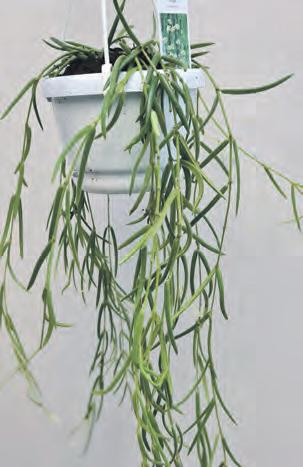
A tropical plant from the rainforests of Central America, the unusual mistletoe cactus produces a mass of thin sprawling leafless stems that can reach up to three feet (90cm) in length, creating a dramatic statement. It gets its name from the small white berries which resemble mistletoe and form on the stem tips in summer.
Grow it in a bright or lightly shaded position out of direct sun. Water well when the top of the compost feels dry and reduce watering frequency over winter.
DONKEY’S TAIL (SEDUM BURRITO; SEDUM MORGANIANUM )
If you're learning how to grow succulents and want to add a trailing variety to your collection, this is a good one to try. It features chunky, textured stems, which reach about 12in (30cm) in length and comprise small, grey-green overlapping leaves.
Donkey’s tail may be sold as Sedum burrito or Sedum morganianum – the former has oval leaves while the latter has slightly longer, teardrop-shaped foliage, but both turn purplish-pink in strong sun. Small pink flowers also appear at the tips of the stems in summer. Overwatering is one of the biggest houseplant mistakes.

HOYA LINEARIS
These are very easy plants if you keep the soil on the dry side.
This variety reaches maturity between two and three years, at which point it will begin to flower. Hoya linearis blooms in late summer to early autumn, and flowers last for about two weeks. Like other hoyas, flowers form in clusters made of individual, star-shaped blooms.
It is also known as Hindu Rope and is one of the most expensive houseplants because of its unique variegation.
NEMATANTHUS GREGARIOUS
This is an easy to grow trailing gesneriad with small glossy leaves and bright tubular pouch shaped flowers. They withstand hot and cold temperatures, along with drought and low humidity. The leaves are variegated cream, yellow, and light-green tinged pink. The most commonly cultivated species of this genus are Nematanthus australis N gregarious, and N wettsteinii. Their orange blossoms look like corn or goldfish, which is why this genus has the common name, ‘goldfish plant.’
Donkey’s Tail (Sedum burrito) Mistletoe cactus (rhipsalis baccifera) Spider plant (chlorophytum comosum) Hoya linearis Lipstick plant (Aeschynanthus radicans)✔ Willow Growers
✔ Wildlife Friendly Plants
✔ Herbs & Edibles
Starcross Devon www.reallyusefulplants.co.uk
Cedar Nursery, Sandy Lane, Romsey SO51 0PD Tel: 01794 367511
Web: www.southernwaterscapes.net

Email: swac.1@virginmedia.com
10% OFF PLANTS WITH THIS ADVERT
EVERYTHING FOR YOUR GARDEN POND
• Extensive range of quality aquatic and bog plants
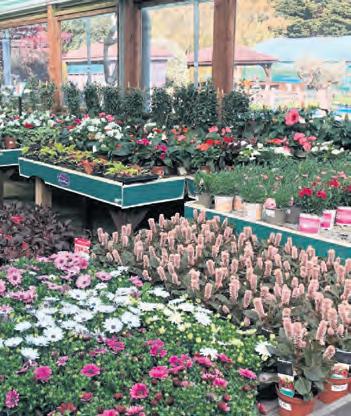

• Large range of cold water fish from goldfish to high grade Japanese Koi

• Expert technical advice on pumps, filters, water quality and fish health
• Everything for building and maintaining your pond • Experienced and knowledgeable staff
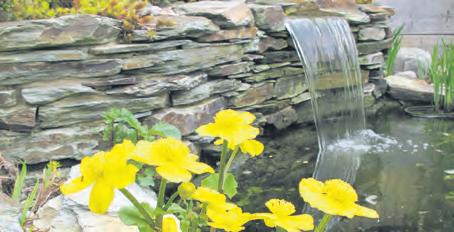
Tel: 01329 834407
www.mudislandgardencentre.com


Southwick Road, Wickham, Hampshire PO17 6JF
Open 7 days a week, inc Bank Holidays 9am-5pm
Excellent range of seasonal plants now in

All the gardening sundries you need in our shop, as well as beautiful gifts. Why not pay us a visit...

There is increasing evidence to support what many gardeners have thought for some time–that being in a garden, growing plants and even just mowing the lawn can be beneficial for our health. Being in the natural world is vital for our health and wellbeing. We don’t always have the time or resources to travel to lakes, mountains or the seaside, but we can be in nature closer to home and still benefit from it.
In a new book How Plants Can Save Your Life: 50 Inspirational Ideas for Planting and Growing, the environmental horticulture expert Dr Ross Cameron explains how gardening and growing plants can make you healthier, backed up by scientific research.
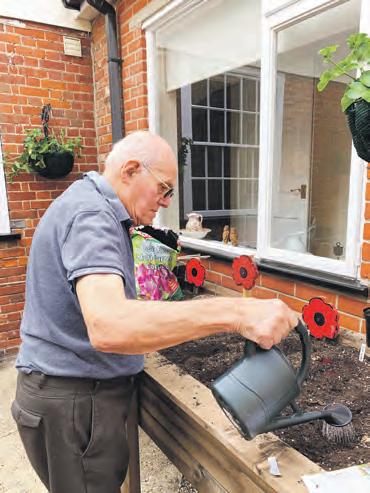
Simply being around greenery has the power to reduce anxiety and stress, taking us away from everyday problems and not only relaxes us, but can keep our minds young and help our physical wellbeing. By growing plants you can do even more for your general health.
Dr Cameron knows what he is talking about – he is an adviser to the Royal Horticultural Society and Research Director within the Department of Landscape Architecture at the University of Sheffield. He has published more than 70 academic papers and book chapters on landscape plants and urban green spaces, and much of his research has been into the ways that plants help human society.
But this is not a technical book, although there are some scientific explanations for the health benefits we get from gardening. Ross Cameron writes in a lively, accessible way, with short chapters, the book has a colourful modern design with beautiful illustrations by the artist Romy Palstra, and there are side notes alerting us to the health benefits of each ‘idea’.
The 50 ideas include the basics of growing seeds and cuttings, gardening with wildlife in mind, how to dampen intrusive noises using green barriers to enjoy relaxing peace and quiet, the benefits of keeping indoor plants, and getting on with mowing the lawn which can improve cardiovascular function – but not being obsessed about it being immaculate, letting it grow longer and if possible leaving some areas uncut for a few weeks to aid wildlife.
He tells us to grow superfoods, especially the common cabbage which has a page giving ten specific health benefits from cancer prevention to the repair of stomach ulcers, boosting immunity to lowering cholesterol, and the relevant scientific proof: cabbage contains among many other vital nutrients, minerals including calcium and magnesium that aids bone construction and helps to prevent osteoporosis in later life.
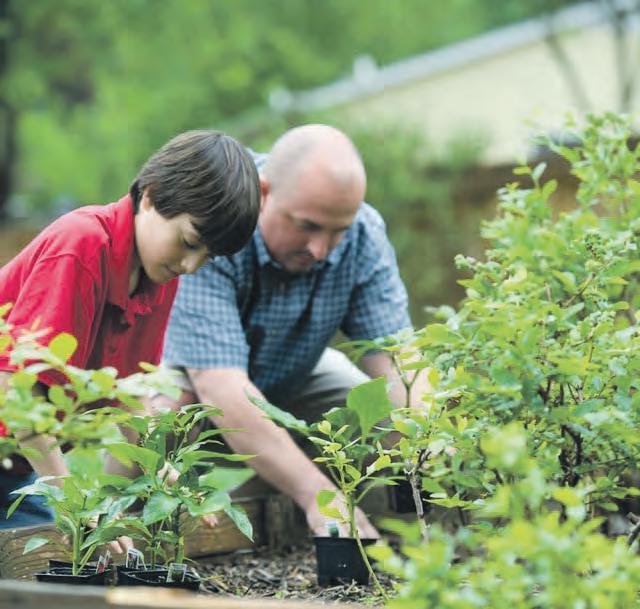
• Reduced frequency or severity of depression
• Reduced anxiety and stress
• Delays in the onset of dementia
• Increased feelings of joy
• Improvements in physical fitness
• Enhanced self-esteem
• Better communication skills
• Better diet

• Air quality – plants can trap and deactivate harmful compounds in the air
• Biophilia – an intimate relationship with nature
• Human microbiome – natural occurring microbial communities affect our gut activity, and thus other aspects of our health
• Phytoncides (essential oils) – plants release these chemicals, which have anti-cancer and other beneficial properties that we can absorb
• Stress reduction – viewing green features affects our physiology and relaxes us
• Thermal comfort – plants shade and cool us during hot weather
• Attention Restoration – first put forward in 1989, this theory suggests that the natural world helps us to unwind, to escape from the source of stress (called ‘Being away’), to be distracted (‘Soft fascination’) with features we can be immersed in (‘Extent’) and that we find interesting (‘Compatibility’).
So, plant buddleia to enjoy the butterflies that feed on its nectar, chill out with the cool plant colours of blue, white and green, grow scented plants, roses, honeysuckle or jasmine, to enhance your mood, sow single petal annuals to attract bees and other pollinators, create a small pond, and plant berried shrubs and small trees such as rowan to encourage birds. Indoors, grow succulents and house plants to improve air quality, to become relaxed as you nurture them, and orchids to transform a room.
Simply being around greenery has the power to reduce anxiety and stress
There are so many ways in which plants help us. Today’s pharmaceutical industry has come a long way from its roots in herbal medicine and the physic gardens of the 17th century. Ross Cameron makes the argument that plants under certain circumstances can save our lives. He adds that we must not squander that by reducing their chances of survival – our relationship with plants must be mutual and not exploitative.
That means gardening sustainably, thinking carefully about the resources you might use and where they come from – do they have a high carbon footprint? Building up natural pest predators rather than using pesticides, going back to manual tools rather than those that use lots of electricity, using natural features rather than too much hard landscaping, all these add up to a garden in harmony with the natural world that will give contentment and good health to us gardeners.
The wild carrot is pale, thin and tastes bitter. The cultivated carrot, larger and sweeter, is a product of years of selection and breeding. But there is a range of colours in the carrot world, and by eating a mixture of colours you could be widening the range of health-giving compounds (called nutraceuticals) you are ingesting. Purple carrots are full of anthocyanins, purple pigments with antioxidant properties that protect our cells from damage,
How Plants Can Save Your Life by Dr Ross Cameron. Published by Greenfinch, an imprint of Quercus Editions Ltd £25.It’s not only rewarding to grow seedlings and to create, nurture and maintain a garden – it’s one of the most important things we can do for our health and long lifeso are linked to protection from various cancers and heart disease.
So how do you know if that plant you are looking at in the ground is really a weed? Pull it up. If it comes out easily, it wasn’t a weed! Although that’s not really the true definition, it seems to be the case, often.
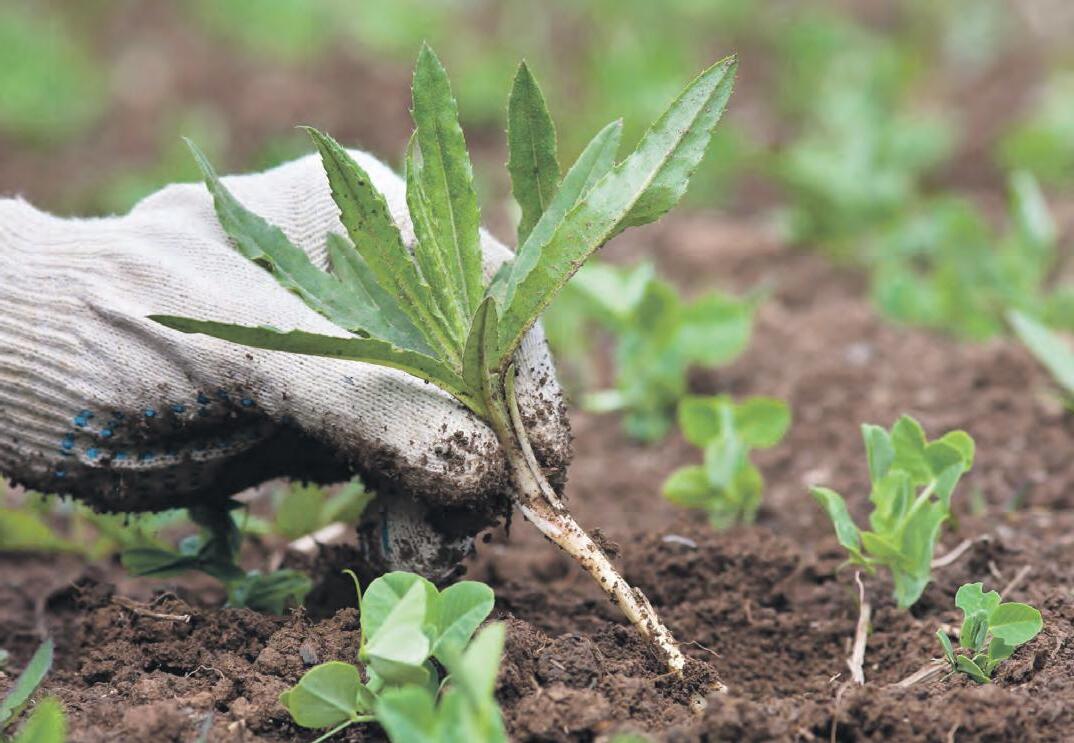
But just what is a weed anyway? The most widely accepted definition is simply “a plant out of place”.
On my allotment I am well known for not tolerating weeds. So, I get lots of questions about how to control weeds in lawns and gardens organically and selectively. To be honest it isn’t easy, even for someone like me who has been gardening for 25 years. It is a challenge, but with patience and dedication it can be done.
First, the best defence is a good offence. Take lawns for example. Beyond manual methods, such as hand pulling, once weeds are present, organic controls are unavailable to selectively eliminate only the weeds. Promoting the health and vigour of the lawn is also the best way to starve off, shade out and out compete the weeds too.
Commercially available weed killers usually contain glyphosate, a controversial chemical linked to several cancer cases in the United States. While glyphosate is unlikely to be used in sufficient quantities at as to cause harm for the home gardener, you may want to avoid using it. There is also research to suggest that glyphosate can adversely affect honey bees. It appears that it affects the microbial community in the bees’ digestive system, making them more prone to deadly infections.
So why not try making your own homemade weedkiller, from ingredients you already have in the store cupboard? Salt, vinegar and lemon juice are just a few of the items that can be used to make weed killers.
But when you’re ready to manage weeds with organic controls, there are several options. I’ve listed some of my favourite methods using eco-friendly options.
Hand-pulling or manual extraction has an element of satisfaction that no other weed control method can offer. If you like instant gratification, hard work is the only way to go. It’s also one of the few ways for selective control.
Although highly satisfying, I realize it’s not always a practical solution to the problem. Time and ambition are usually the two most important assets to taking on a manual project. However, hand weeding in any size garden is easiest after a soaking rain. The soil is soft and roots easily yield to even the gentlest tug.
But be aware of one caveat. Tap rooted weeds must be pulled out in their entirety, making sure to get the entire root! Otherwise, any remaining piece will provide sufficient energy for that weed to regenerate a new plant.
One of the most effective organic weed control techniques available and certainly one of the most environmentally friendly, is to provide natural barriers to weed formation. A layer of mulch two to four inches thick is a very effective means of preventing most weeds from germinating.
I’ve used just about every type of mulch barrier available, including traditional bark and straw mulch, plastic sheeting and wet newspapers with additional mulch on top of that.
These methods affect plants on contact by burning or desiccating the cell structure of the plant.

Boiling water works well at killing most weeds with one application. Some weeds, especially those with tap roots such as dandelions may need multiple applications. Acetic acid (vinegar) works but common household vinegar at five per-cent concentration is not effective for mature weeds. Minimum concentrations above seven per-cent are needed to manage tougher weeds and multiple applications may be necessary with tap-rooted weeds such as thistle. Use caution when using acetic acid as it can burn skin and eyes on contact.
Plant-based ingredients such as citric oil, clove oil, and garlic are non-selective postemergent herbicides also. Please be careful as they will injure or kill all vegetation they come in contact with. Tougher weeds usually require multiple applications for complete control. Ready to use products are available through organic gardening supply sources online and in some garden centres.
When salt is absorbed by plant root systems, it disrupts the water balance and causes the weed to eventually wilt and die. But salt by itself doesn't make a very effective weed killer.
Flame weeders are those devices that use the intense heat of a concentrated flame to destroy the cell structure of the plant. Typically powered by a propane canister, these devices are portable and effective. Simply pass the flame over the weed for several seconds. It is not necessary to visibly burn or ignite the weed. A few seconds of intense heat is all that is necessary.
Like the other methods listed above, because the roots are unaffected, the toughest weeds may require multiple applications. Use extreme caution when working with this tool.
No matter which methods of weed control you prefer, prevention is still the best way to make sure you keep the weeds from spreading next year. Although they can still come into your garden through other means, eliminating weeds on your soil before they go to seed will save you many hours of work next year and beyond.
Alliums are one of those rare plants that are beautiful and spectacular without causing you any effort to grow.
It is a case of putting them in the ground and up they come in the ground and they magically do this spring after spring. They are hands down bulbs that give so much pleasure because they provide weeks and weeks of real glamour in borders.
From the humble onion family, they are the unlikely sirens of the garden – their globes are held aloft on long, strong stems, and they are excellent for cutting when in flower or as dried, decorative seed pods.
You can’t beat alliums for adding late spring and summer pizzazz – explore the range of allium bulbs in all shades of purple, as well as white and blue.
These ornamental onions are bold and architectural, with large, rounded heads of usually purple flowers, followed by attractive seedheads.
Weave them through sunny borders or combine them with feathery grasses for best effect.
Allium, also known as flowering onion, is a spectacular and unusual looking flowering bulb that will add interest to any garden. As the name suggests, allium plants are members of the Allium family, which includes such plants as garlic, onions, leeks, and chives.
All these plants produce similar round, pom-pom shaped flower heads, though alliums are the only ones usually exclusively grown for their flowers.

Grow alliums in moist but well-drained soil in full sun. Plant as many as you can afford to buy – the most impressive allium displays arise from mass plantings. It’s a good idea to grow them among low-growing herbaceous plants, which hide their unsightly strappy foliage after flowering. Let allium foliage die down naturally after blooming and consider leaving the flower heads in place as they look attractive, particularly in winter.
When choosing alliums to grow, think about your garden space.

Will you be growing in drifts through the border or planting in bulk, in pots? As part of a prairie planting scheme or something more formal? It’s also important to think about the colour of your alliums – most allium flowers are purple but some come in shades of blue, white, yellow and pink.
Be careful about size of your allium – that’s the flower size as well as the overall height of the plant. Flower sizes range from just a few centimetres to over 20cm (8in) in diameter, while the height of alliums can vary significantly, too.
Large, tall alliums such as ‘Purple Rain’ and ‘Globemaster’ work well when planted individually or in drifts. Shorter varieties such as Allium christophii work well in pots. Drumstick alliums such as Allium sphaerocephalon look great in prairie planting schemes.
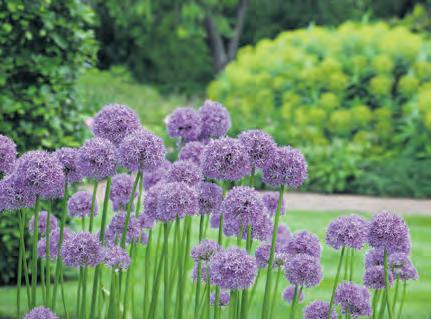
If the soil is moist there’s no need to water them in. In spring, when growth starts to appear, apply a balanced fertiliser to poor soils.
Alliums do best in a sunny spot in a very well-drained soil. They’re not fussy about soil type. Plant taller varieties towards the back of a border and shorter-growing types in the front. Alliums are well suited to growing in pots but their strappy foliage can look unsightly after flowering.
Alliums produce foliage before the flowers appear. This often means they’re better suited to the middle of a border where the faded foliage will go unnoticed while the flowers put on a show. To avoid seeing the faded foliage, plant alliums in amongst ornamental grasses and perennials.
Plant allium bulbs at least four times the depth of the size of bulb (at least 15cm deep). It’s better to plant them too deeply than too shallow. It’s best to not plant more than one allium bulb in the same planting hole, but if you want a more naturalistic display you can plant smaller growing alliums 7-10cm apart, and taller species around 20cm apart.
The best time to plant allium bulbs in the UK is in autumn, typically from September to November. If you don’t plant your allium bulbs by the end of November don’t worry – you should be able to plant them up to the end of December without any problems, just make sure the bulbs are still firm and show no signs of mould or disease before planting (discard any that do). You may find that a late planting means your alliums will flower later than usual in their first year but will catch up in the second year.
After a few years allium bulbs will multiply. In some cases you’ll notice the white bulbs being pushed out of the soil. In late autumn or very early spring carefully lift the bulbs and gently peel off the offsets to replant straight into the soil.
To grow allium from seed leave the flowerheads on the plant and collect the ripe seed and sow it straight away. Bear in mind that growing alliums from seed is a long process, as it will be years before you achieve a flowering plant.
Our popular gardening themed crossword is compiled by Saranda which over the past year has become enormously popular with readers. The winning entry to be drawn by us will receive £100 of RHS gift tokens. Completed entries should be sent to Mount House, Halse, Taunton, Somerset TA4 3AD. Closing date is Friday, 30th June. The winner of our May issue crossword was Trevor Marchant from Cheltenham.
What to do with alliums after flowering?
Once the flowers have faded leave them on the plant until they fall apart as they offer fantastic winter interest. Some gardeners pick the seedheads and dry them in order to use them as a decoration in the house. Allium bulbs can be left in the garden year after year,
Should I deadhead alliums?
You can cut off the spent flower heads at the base but this is not essential as the dried flower heads look attractive in the border.
How many times a year do alliums flower?
Alliums usually flower just once per season. However, if you let some of the flowers develop into seed heads, alliums will self seed so new plants will return next year.
Should you divide alliums?

Allium bulbs should be divided every three or four years. To do this, simply dig around the plant with a trowel and lift the bulbs out. There should be a collection of bulbs, which you can separate gently with your hands. Replant a few in the same spot, and plant the others right away in new locations.
Do alliums get bigger each year?
Yes, alliums will grow back each year. All alliums are long-lived plants although they may fade away if planted in the wrong place – such as in soggy soil types or in shade. Even better is that after a few years they start to multiply so can be a great choice if you’re on the lookout for cheap garden ideas.
Does allium like sun or shade?
Alliums thrive in full sun, but can tolerate part-shade conditions. Soil: A well-drained soil is the most important condition for allium as bulbs may rot if left in wet soil.
What is the best companion plant for allium?
Place alliums behind heavy-foliage plants such as peonies and iris. Good for bedding, and in mixed borders. Flower heads are good for drying. Alliums pair beautifully with a wide variety of perennials including echinacea, phlox, Alchemilla mollis (Lady’s Mantle), achillea (yarrow), and iris.

Ornamental alliums are problem free in the garden but can sometimes be affected by the diseases common to edible alliums like onions and garlic. Onion fly, allium white rot and downy mildew are all common issues for edible alliums that can sometimes affect the ornamental varieties. So you should not plant ornamental alliums where edible alliums have been planted before.
Onion fly
The maggots of the onion fly (which looks like a small grey house fly) do the most damage, eating the roots of plants in the onion family. If this is happening, the plant may fail altogether, or you might notice yellowing leaves.
The bulbs should be dug up – if you see any maggots or larvae, dispose of the bulbs straight away.
This is a fungal disease that impacts the bulb and more commonly affects onions, garlic and leeks. The bulb will show signs of furry white growth and leaves might yellow and wilt. Bulbs should be disposed of –avoid planting any alliums in the affected area in the future as the fungus can survive in the soil for years.
ACROSS
1. Brandy distilled from morello cherries (6)
4. Ukraine city with gardens founded in 1803 (6)
8. Genus of plants commonly called calamus or sweet flag (6)
13. Clever or dexterous (6)
14. Delonix regia or peacock tree (5,9)
16. Over 100 year old food creation named after New York hotel (7,5)
17. Popular table fish in New Zealand (8)
18. Subjugated (8)
19. A gardener’s pursuit of pleasure that is wracked with disastrous consequences! (8,4)
22. One of several supports for a hayrick (12)
23. Jetty or landing place (4)
27. Symbol of plenty with flowers and fruit in a goat’s horn (10)
29. In music, a gliding movement from one note to another (10)
31. Vegetable and Welsh national emblem (4)
32. Taxonomic realm comprising all living or extinct flora (5,7)
37. Northern European tree widely grown for timber (6,6)
38. Nests in the form of mounds built by termites (8)
40. Region of Italy whose chief town is Turin (8)
41. The Cockney Paradise? A large, green space near London (6,6)
43. A lover of ferns? (14)
44. Plastic covering of supermarket flowers (6)
45. They tend to agree with everybody (6)
46. Genus of flowering plants in the sunflower family (6)
47. Modified leaves that encase the developing flower (6) DOWN
1. Any of several members of the Centaurea genus with purplish flowers (8)
2. One who lives in a country area (8)
3. Winter flower in Greek; this is a genus of flowering plants native to China (12)
5. Tall cedar native to the Himalayas (6)
6. Obsolete dialect form of asparagus (10)
7. High mountains especially snow-capped (4)
9. Genus of flowering plants sometimes called swinebread (8)
10. Achievements or fulfilments (12)
11. Plant name given to shrubs Genista hispanica and Spartium junceum (7,5)
12. Where certain coniferous trees are commercially grown (4,6)
15. To or at a distance (6)
20. Genus of plants that include forget-me-not (8)
21. French term meaning out of doors (5,3)
24. Artic flower Papaver nudicaule (7,5)
25. Small passerine birds found in the Northern hemisphere (12)
26. Dog originally bred for herding (6,6)
28. Resistance or dissent (10)
30. Accumulates a large amount of goods (10)
33. Chinese tree whose leaves are used in traditional medicine (6)
34. Aromatic European plant of the daisy family (8)
35. Succulent plant species used widely in cosmetics (4,4)
36. Common name of Fraxinus and widely represented in Celtic mythology (3,5)
39. Indian tree prized for its timber (6)
42. Elegant and stylish (4)
ACCOMMODATION
Secluded cosy cabins & lodges in wooded valley running down to Wembury Bay & SW Coastal Path

Plymouth, Dartmoor & lovely South Devon Villages & Towns in easy reach. Pets Welcome. Forest School. Tel: 01752 862382 www.churchwoodvalley.com
Carmarthen Bay South Wales
Seafront chalet situated on estuary.
Sleeps up to 6. Seaview. Well Behaved Dogs Welcome. Free WIFI. Open from 1st March - 31st Dec. For Brochure
Tel: 01269 862191
GLORIOUS NORTH DEVON. Only 9 cosy caravans on peaceful farm. Wonderful walks in woods & meadows. Easy reach sea, moors & lovely days out. £125-395pw. Discount couples. Nice pets welcome. 01769 540366 www.snapdown.co.uk
BOSWORLAS NEAR SENNEN/ST
JUST, CORNWALL. Cosy Cottage, rural views, Sleeps 2-4 01736 788709 www.bosworlas.co.uk

ACCOMMODATION HOLIDAY COTTAGES

SANDWAYS
HOLIDAY COTTAGE SIDMOUTH, DEVON
A quiet holiday bungalow near Sidmouth, overlooking the Donkey Sanctuary. Ideal for walkers and nature lovers. Available to rent from April to October. Sleeps 4.


jandtmercer@gmail.com www.sandwaysholidaycottage.co.uk
07842 514296
West Dorset
Peaceful, comfortable apartment in Victorian stable block, 1/2 mile Charmouth, country walks, sunny garden, sleeps 2/4. No pets. Perfect for all seasons!
Enquiries 07786 118762
WYE VALLEY/FOREST OF DEAN. Fully equipped single-storey cottage with two en-suite bedrooms. Wi-fi.Recently awarded Visit England 4-star GOLD. Rural retreat, shops/pubs one mile. Enquiries welcome. Tel: 01594 833259 www.cowshedcottage.co.uk
ACCOMMODATION WITH BEAUTIFUL GARDENS
BED
Welcome to Redcroft
Hampshire Country House Fabulous Gardens Comfortable Bedrooms 5
Mins walk from Hamble River Within 15 mins Southampton & Portsmouth Call 07768997979
Gloucestershire Quality
Bungalow B&B
Ensuites, rural, large garden, paddocks, sheep and fruit. Ideal Cotswolds, Malvern’s, Forest of Dean, cycle storage, ample parking, Wi-Fi £40 p.p.p.n. Tel: 01452 840224 sheila.barnfield1960@gmail.com
CARDS, PRINTS & GIFTS
Penrice Castle Gower
16 holiday cottages on an 18th century Estate on the Gower Peninsula with beautiful Grade I listed historic park and gardens.

Tel: 01792 391212
www.penricecastle.co.uk
A beautiful range of plantable greeting cards & earth kind gifting for every occasion


Let the love grow and enjoy 10% off on our website using code ‘GARDENS2023’ Selling to individuals and trade info@latitude50landscapes.co.uk www.latitude50landscapes.co.uk
A range of over 200 greetings cards and prints from the flower paintings of ANNE COTTERILL

Near Stratford-upon-Avon
Lovely self-catering cottage in peaceful location: large garden.

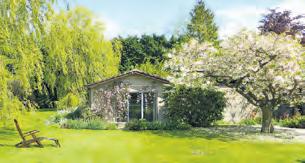
Sleeps 2. Perfect for famous gardens, NT properties & Cotswolds.
Tel: 01789 740360
www.romanacres.com
Peace, Privacy, and Stunning
Views!
4* Delightful cosy cabin for 2, nestling between Wye and Usk Valleys. Shirenewton village & pubs close by. Wonderful walks, splendid castles, bustling market towns. Perfect for all seasons!
Tel: 01291 641826
Email: lynne@bryncosyn.co.uk www.bryncosyn.co.uk
NORTH DEVON NEAR CLOVELLY. 3 delightful cottages situated in 12 acres of idyllic countryside. Sleeps 2-4. 1 Wheelchair friendly. Brochure: 01237 431324 www.foxwoodlodge.co.uk foxwoodlodge@outlook.com
ADVERTISE HERE FROM JUST £2 PER WORD
classified@countrygardener.co.uk

We sell to both individuals and trade. No order too small. Contact us for your free catalogue.
Mill House Fine Art Publishing, Bellflower Gallery, Market Place, Colyton, Devon EX24 6JS Tel. 01297 553100 info@millhousefineart.com www.millhousefineart.com

REACH 300,000* LOYAL READERS WITH Classified advertising classified@countrygardener.co.uk
ECOLOGICAL LANDSCAPING CONSULTANCY & DESIGN

Specialists in Nature Recovery & Habitat Enhancement


Providing Nature-Based Solutions for: Ecological Landscape Design, Wildlife Ponds, Lakes, Wetlands, Nature Landscaping, Conservation Arboriculture.
Consultancy & Design.
Management & Construction.
Tel: 01392 240 877
Restoration@LostHabitat.uk LostHabitat.uk
FRUIT/VEG CAGES

GARDEN BUILDINGS

GARDEN PLANTS/ACCESSORIES


The subscription costs just £20 and guarantees a 10 times a year magazine packed with information , gardening advice, local events.



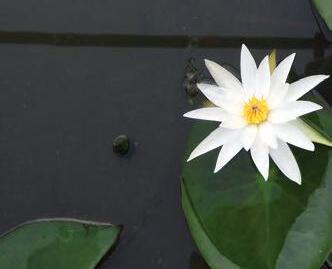

You can select from one of our five editions of the magazine which is relevant to where you live.
This is a subscription just for me *
This is a gift (send next available issue) *
Please choose your region by ticking the box: Cotswolds * Devon * Dorset * Somerset * Hampshire *
Your details:
Title Forename Surname



Address Postcode Tel No

Details of gift recipient: Title Forename Surname Address Postcode Tel No





Complete this form and include a cheque for £20 made out to Alro Publishing Ltd and send to: Magazine Subscriptions, Country Gardener, Mount House, Halse, Taunton, Somerset TA4 3AD.
Remember to tell us which one of the five editions you would like to receive.
When I was young and politicians were honest, health care professionals didn’t strike, teachers were respected, and a woman was safe alone with a Police Officer, looking ‘healthy’ was all about having a suntan. Stretched out on lilos, sun worshipers would turn and turn again like some human rotisserie in their efforts to achieve an even suntan "On her back and on her legs" (Peter Sarstedt, if you are wondering.).
Then somebody noticed a hole in the ozone layer! Our Department for Environment, Food and Rural Affairs States:
The depletion of the ozone layer leads, on the average, to an increase in ground-level ultraviolet radiation, because ozone is an effective absorber of ultraviolet radiation.
86 per-cent of skin cancers are due to exposure to sunlight...
Cancer Research UK states:
There are around 16,700 new melanoma skin cancer cases in the UK every year, that's 46 every day (20162018).
Since the early 1990s, melanoma skin cancer incidence
rates have more than doubled (140 per-cent) in the UK. Rates in females have around doubled (106 per-cent), and rates in males have almost tripled (186 per-cent) (2016-2018).
Tree canopies, by varying degrees, block ultraviolet light: The University of Purdue points out: “If a person is standing in the sunlight under a tree that provides 50 percent coverage, it will take about 50 minutes for them to burn instead of 20 minutes. However, that same person standing in the full shade under the same tree could be there for 100 minutes before they received too much ultraviolet radiation”.
UV damage builds over time; however, we tend to receive the bulk of our damage when we are children. So put the playhouse under the tree.
By the way, UV light doesn’t just burn you and cause skin cancer – it also damages your immune system. Then there are urban heat islands: The 2003 heat wave was considered responsible for 14,802 and 2,045 excess deaths in France and England and Wales respectively. Many of these deaths occurred in urban areas because of the combined effect of the heat wave with the urban micro-climate. Urban heat islands are caused by hard surfaces absorbing heat all day and then radiating it out at night. It was higher night-time temperatures which proved to be most lethal.

Trees and vegetation lower surface and air temperatures by providing shade and through evapotran spiration. Shaded surfaces, for example, may be 11to 25°C cooler than the peak temperatures of unshaded materials. If the heat is not in the surface in the first place it cannot radiate out later.
Of course, when we are not burning to a crisp these days, we are drowning in floods. Rain falls on the
same hard surfaces which did all the heat radiating and rushes towards the nearest drain. The drain is overwhelmed, and the water backs up and floods places. Figures are few and far between and difficult to relate to different circumstances, but an idea is given by data which indicated that a 40-year-old tree will intercept 4,500 gallons of rainwater every year. That is water that sticks on the leaves, twigs, branches and trunk and does not immediately fall to the ground.
One of the difficulties with trees is that you have to plant them 30 years before you need them, but better late than never.
As a species we are naturally forest dwellers. It is after we came out of the forest that it all started going horribly wrong for us and our environment. The sooner we understand that and start making our living areas more like forests and less like bakers’ ovens the better. The 1970s are gone, my lovely.
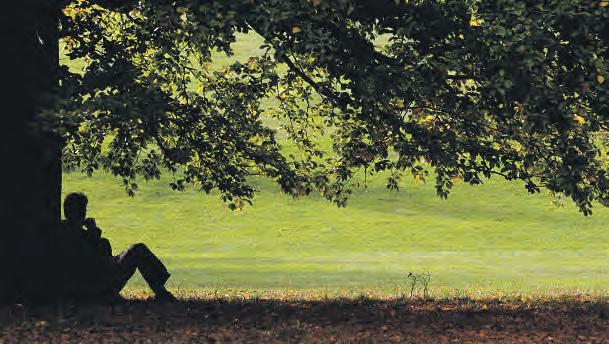
www.treeadvice.info
Cath Pettyfer - Devon cath.pettyfer@countrygardener.co.uk Tel: 01837 82660
Corina Reay - Cotswolds & Dorset corina@countrygardener.co.uk Tel: 01823 410098
Classifieds classified@countrygardener.co.uk
Design & Production
Aidan Gill aidan@countrygardener.co.uk
Gemma Stringer gemma@countrygardener.co.uk
Distribution & Stockists
Pat Eade distribution@countrygardener.co.uk
Accounts and subscriptions
Heather Rose heather@countrygardener.co.uk
Mark Hinsley sees the enormous value of the shade that our trees provide and urges us all to make our living areas more like forests.
Mark Hinsley, of Mark Hinsley Arboricultural Consultants Ltd, offering tree consultancy services.
"One of the difficulties with trees is that you have to plant them 30 years before you need them, but better late than never."
A new list celebrates the wildlife found in our gardens which makes them safer, more biodiverse places to enjoy
The Royal Horticultural Society (RHS) has published the list of most-asked-about beneficial garden biodiversity for the first time, to celebrate the wildlife found in gardens and highlight how encouraging more species into our outdoor spaces can bring multiple benefits.
The list is drawn from enquiries to the RHS Gardening Advice Service, which gets thousands of queries from gardeners every year.
Topping the list are lichens, which can often be found growing on trees or shrubs. Lichens provide food for other garden wildlife and create new habitats by providing shelter for invertebrates and nesting materials for birds and mammals. Lichens are often associated with good air quality as they carry out photosynthesis to capture atmospheric carbon, and certain lichens also absorb atmospheric nitrogen, a common pollutant. They regulate water and humidity levels by soaking up moisture during wet weather and slowly releasing it as water vapour afterwards.
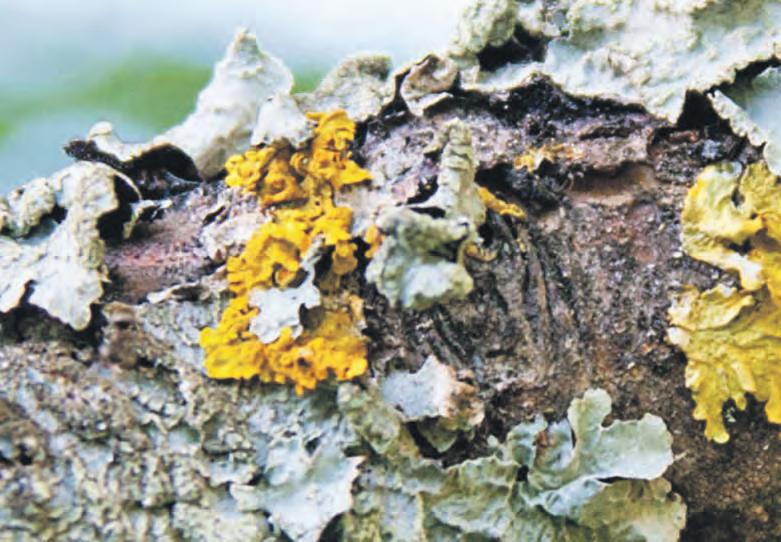
The insects at the top of the list, pollinators and ladybirds, will probably be most familiar as being beneficial to gardeners. Since 2012 the RHS has produced the Plants for Pollinators list, plants which are very attractive to and provide food for pollinators, including bees and butterflies.
Ladybirds primarily eat aphids so have long been considered a friend of gardeners - it is said that a single ladybird can eat 50 aphids a day, or around 5,000 in a lifetime.
The rose chafer beetle (Cetonia aurata) is an eye-catching species on the list. This bright metallic green beetle often appears from May and the larvae feed on dead, decaying matter, helping composting in the garden.
Social wasps, often much maligned, are vital garden predators, feeding on everything from caterpillars to green fly. Adult hoverflies are often wasp mimics, having no sting they are vital pollinators. The larvae of many species are predators of blackfly and other aphids. Beneficial fungi also appear in multiple slots in the top ten, emphasising a growing interest in fungi and their role in ecosystems. Around 1,000 visitors engaged with activities to celebrate UK Fungus Day at RHS Garden Wisley in October 2022, more than ever before, attending fungi walks and talks and learning how to inoculate logs with mycelium. Sulfur tuft and inkcap mushrooms are often confused for honey fungus as they appear in groups in the autumn, but these beneficial species help recycle dead wood and support plant health. They release micronutrients and humic acid that enrich soils and helps retain moisture, and the presence of fungi in soil improves its structure. By adding
woody mulch or retaining pruning cuttings from healthy trees gardeners can encourage beneficial fungi in their gardens.
Slime moulds are single-celled organisms that fuse together to create a supergroup which moves as a unit in search of food. They eat bacteria which decompose plant material, contributing to the nutrient cycling in a garden as they in turn are eaten by invertebrates such as nematodes.
The top 10 beneficial garden species for 2023 are:
1. Lichens
2. Native ladybirds

3. Solitary bees (Aculeate hymenoptera)


4. Sulphur tuft fungi (Hypholoma fasciculare)
5. Slime moulds
6. Rose chafer beetle (Cetonia aurata)
7. Ink cap mushrooms (Coprinoids)

8. Hoverflies
9. Social wasps
Liz Beal, RHS Plant Pathologist, said: “We have seen a huge increase in gardeners wanting to find out more about the organisms they can encourage into their garden to naturally ward off the species that can be more damaging to their plants. Many of the gardeners that get in touch are also very curious about the wildlife they find and what they do, rather than looking for ways to get rid of them. A healthy garden ecosystem is home to a wide variety of wildlife, and we hope this list will help celebrate some of the friendly garden species that have a whole host of benefits for our plots and the wider environment.”
The RHS is committed to becoming biodiversity positive by 2025 as set out in the charity’s 2021 Sustainability Strategy. To aid this, the RHS is encouraging gardeners to focus on the benefits of having a biodiverse garden and the contribution each species makes to a healthy ecosystem and the ways increased biodiversity can prevent any one species becoming too prevalent and harming plants.
For more information on wildlife gardening, visit: www.rhs.org.uk/wildlife
RHS members get free access to the charity’s one-to-one Gardening Advice Service, available by phone or email. Find out more about becoming a member at: www.rhs.org.uk/join
For more information visit:

